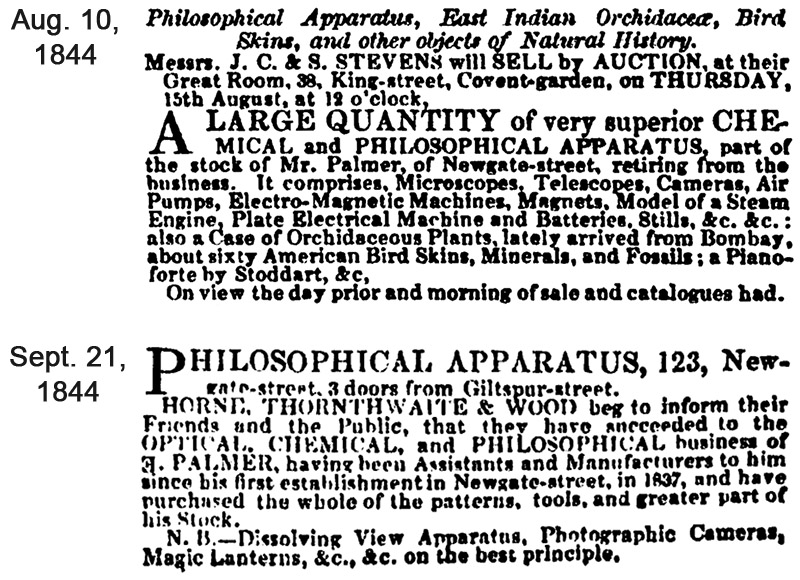
Figure 1. Advertisements from 1844 issues of “The Athenaeum”. On August 10, Edward Palmer announced the auctioning of his goods, while the September 21 advertisement announced the opening of Horne, Thornthwaite, and Wood, as successors to Palmer.
Horne, Thornthwaite and Wood / Horne and Thornthwaite / E.G. Wood
Fallon Horne, 1814-1858
William Henry Thornthwaite, 1819-1894
Edward George Wood, 1811-1896
William Ackland, 1821-1895
John Overstall, 1867-1941
William Thomas Overstall, 1869-1957
by Brian Stevenson
last updated October, 2020
This series of London businesses manufactured and retailed microscopes, cameras, telescopes, other optical equipment, chemicals, and laboratory supplies from 1844 until 1911. Fallon Horne, William Thornthwaite, and Edward Wood had been employees of, or suppliers to, a scientific supply shop that was operated by Edward Palmer. The trio bought up the bulk of Palmer’s stock upon his retirement from that trade, in August, 1844. Wood later separated from the partnership, then rejoined. Sons of both Thornthwaite and Wood became partners over time, as did also optical surgeon and mechanical engineer William Ackland, and a silent partner named Francis W. Barnes. The firm was bought in the mid-1890s by two employees, the brothers Overstall.
As with the other entries in this historical series, I have relied on primary resources as much as possible. In doing so, some long-held assertions have been disproven. Most notably, historical records indicate that three men - Horne, Thornthwaite, and Wood - owned the business from its very beginning in September, 1844 (Figure 1). Some authors have asserted that the business was begun by Horne and Thornthwaite, and that Wood joined them 1-2 years later as a manager. There are no known historical records implying that Wood was not an equal partner from the beginning - indeed, he was highly skilled in optics and chemistry.

Figure 1.
Advertisements from 1844 issues of “The Athenaeum”. On August 10, Edward Palmer announced the auctioning of his goods, while the September 21 advertisement announced the opening of Horne, Thornthwaite, and Wood, as successors to Palmer.
Businesses associated with Horne, Thornthwaite, and Wood operated under several names and in different locations over a period of nearly 70 years. Analyses of their advertisements and of legal documents reveals the following timeline:
Horne, Thornthwaite & Wood, 1844-1854 (also known as Horne & Co. during that time)
1844, September: opened at 123 Newgate
1850: earliest evidence of expansion into 121 Newgate, followed in 1856 by inclusion of 122 Newgate
1854, August: Wood left, firm became Horne & Thornthwaite
Horne & Thornthwaite, 1854-1885
1854-1874: address given as 123 Newgate, with/without 121 and/or 122
1874: move to 3 Holborn Viaduct between Jan 31 and Feb 7
1875: move to 416 Strand between June 27 and July 2
1883/1885: partnership dissolved on Dec. 24, 1883; finalized on Feb 6, 1885 (consisted of Thornthwaite, Barnes, and Ackland). Wood rejoined the partnership.
Horne, Thornthwaite & Wood, 1885-1893
1885: at 416 Strand
1893: advertisements were published by Horne, Thornthwaite, and Wood in early October, but the business name had reverted to Horne and Thornthwaite by mid-November.
Horne & Thornthwaite, 1893-1911
1893: acquired by Ackland and the Overstall brothers
1911: both Overstall brothers moved to Canada
E.G. Wood, 1854-1895
1854: 117 Cheapside, lived at that address during the 1861 census, which was held at the end of March
1862: moved to 74 Cheapside, London.
1895: Wood died
Wood and Co. / E.G. Wood
1895 onward: 74 Cheapside, electrical business that was operated by L.A.S. Wood (EG Wood’s grandson), with some retail of optical equipment.& Thornthwaite, 1893-1911
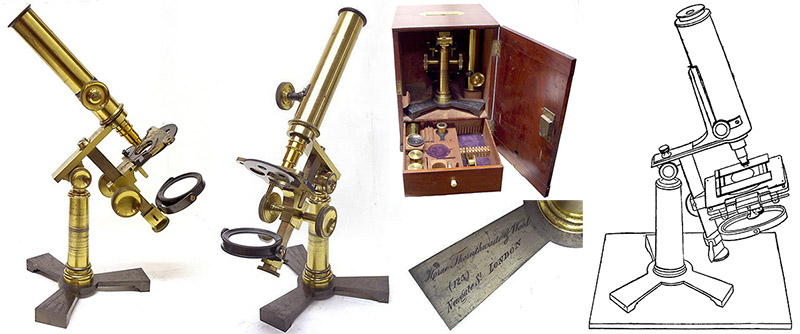
Figure 2A.
The earliest known model of microscope that was manufactured by Horne, Thornthwaite, and Wood. The drawing on the right was featured in an 1846 mini-catalogue of their microscopes, bound within Alfred Smee’s ‘The Potatoe Plant’ (see Figure 15, below). As with the other microscopes illustrated below, this style does not directly duplicate that of any other known maker, implying that Horne, Thornthwaite, and Wood manufactured this and the other illustrated microscopes. Adapted by permission from http://www.antique-microscopes.com/photos/Horne-Thornthwaite-Wood.htm.
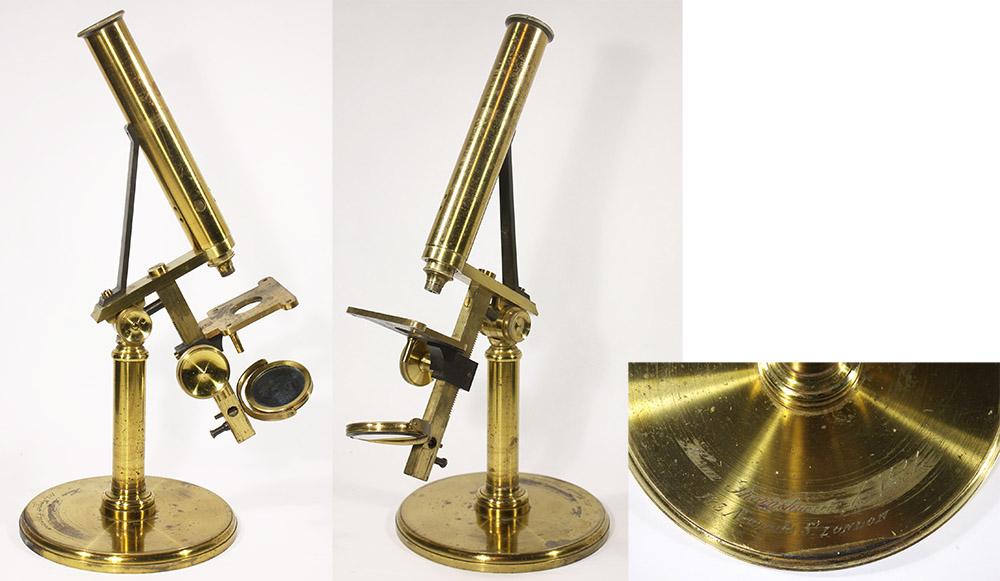
Figure 2B.
A compound microscope that is very similar to the one above. The solid-brass base, which is approximately 6 inches / 15 centimeters in diameter, is inscribed "Horne, Thornthwaite &
Wood, 123 Newgate". The address dates it to ca. 1844-1850.
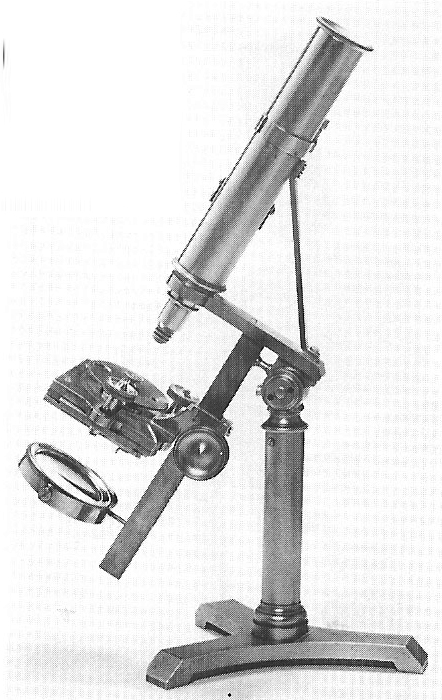
Figure 2C.
A Horne, Thornthwaite, and Wood microscope as above, with a tripod foot. Adapted for nonprofit, educational purposes from a printed auction catalogue.
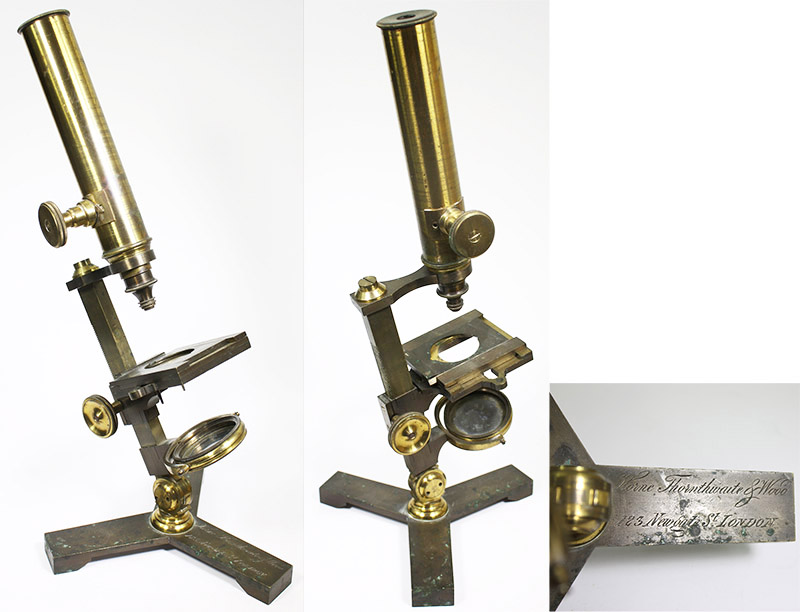
Figure 3.
Compound microscope by Horne, Thornthwaite, and Wood, with address 123 Newgate, ca. 1844-1850.
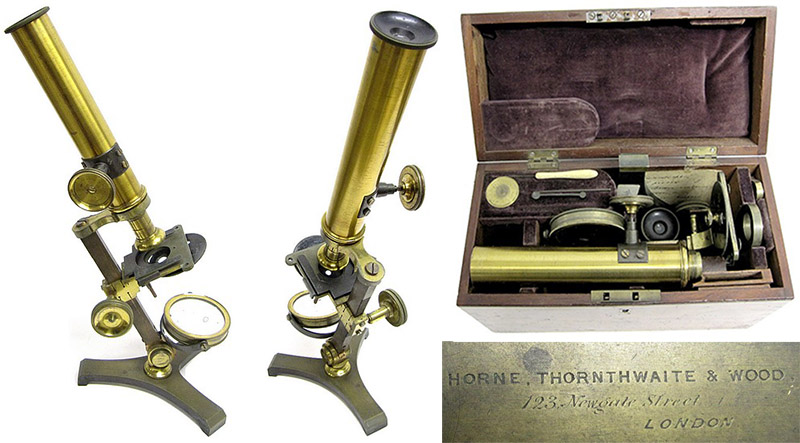
Figure 4.
Horne, Thornthwaite, and Wood compound microscope, with address 123 Newgate, ca. 1844-1850. http://www.antique-microscopes.com/photos/HTW.htm.
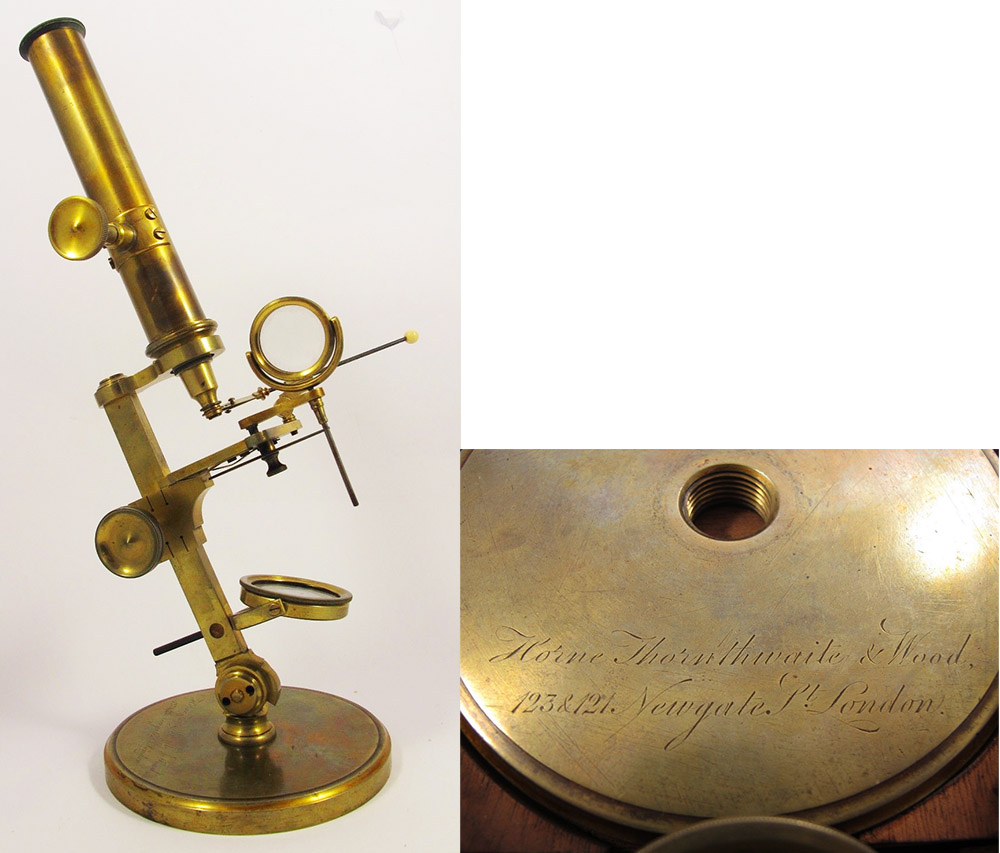
Figure 5.
Horne, Thornthwaite, and Wood compound microscope, with address 123 Newgate, ca. 1844-1850. Adapted for nonprofit, educational purposes from an internet sale site.
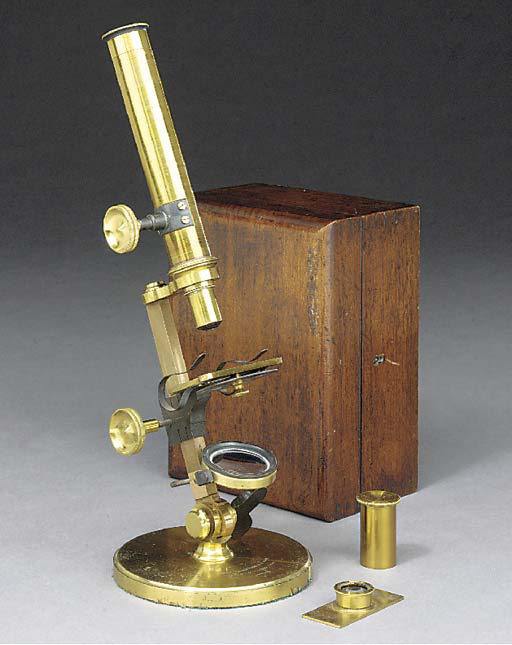
Figure 6.
By Horne, Thornthwaite, and Wood, 123 Newgate, ca. 1844-1850. Adapted for nonprofit, educational purposes from an internet sale site.
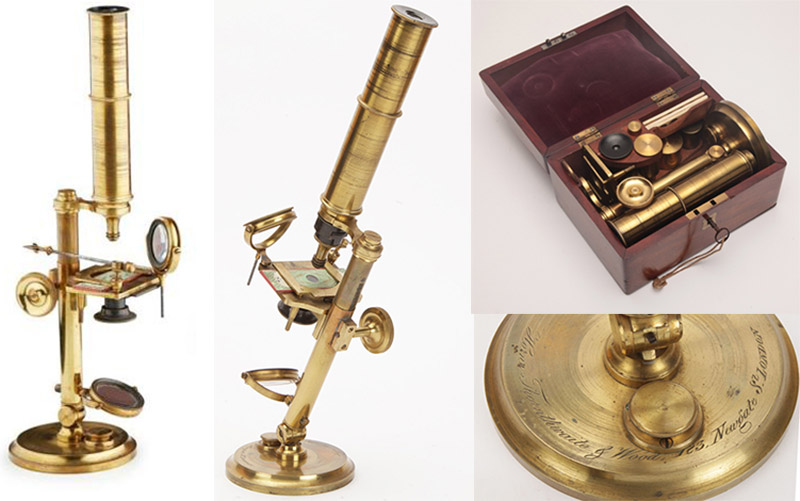
Figure 7.
Horne, Thornthwaite, and Wood compound microscope, with address 123 Newgate, ca. 1844-1850. Adapted for nonprofit, educational purposes from an internet sale site.
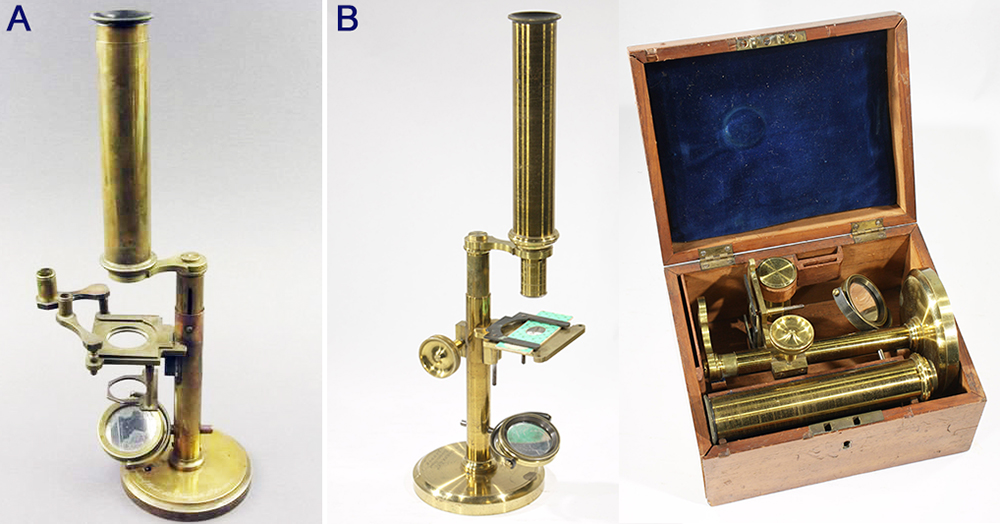
Figure 8.
Two identical microscopes, both ca. 1844-1850.
(A) The base is engraved "Horne, Thornthwaite, and Wood, 123 Newgate".
(B) Engraved "Horne & Co., Newgate Street". The business appears to have used the two names interchangeably during this period. Images adapted for nonprofit, educational purposes from http://library.unimelb.edu.au/teachingobjects/objects/micrographia-by-robert-hooke.
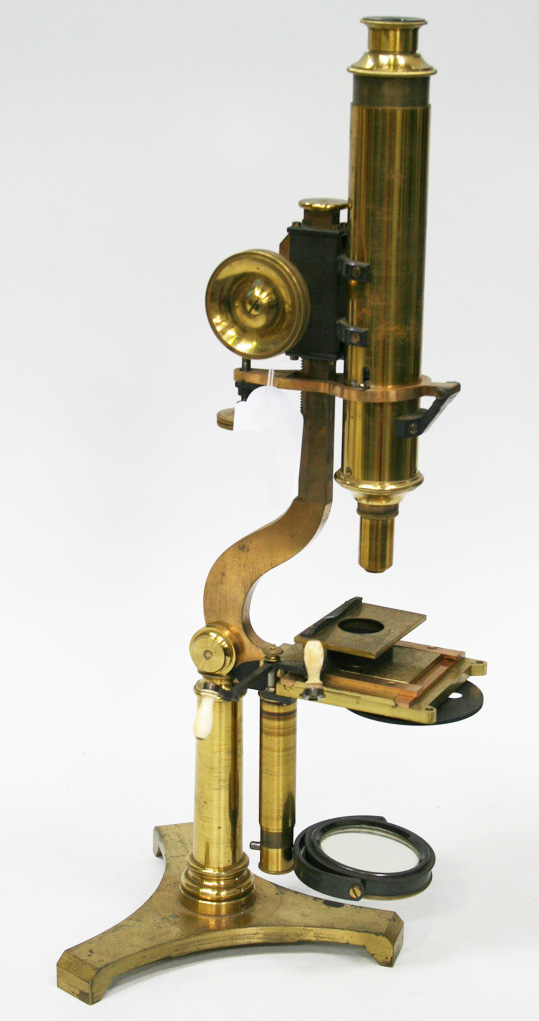
Figure 9.
By Horne, Thornthwaite, and Wood, 123 and 121 Newgate, ca. 1850. Adapted for nonprofit, educational purposes from an internet sale site.
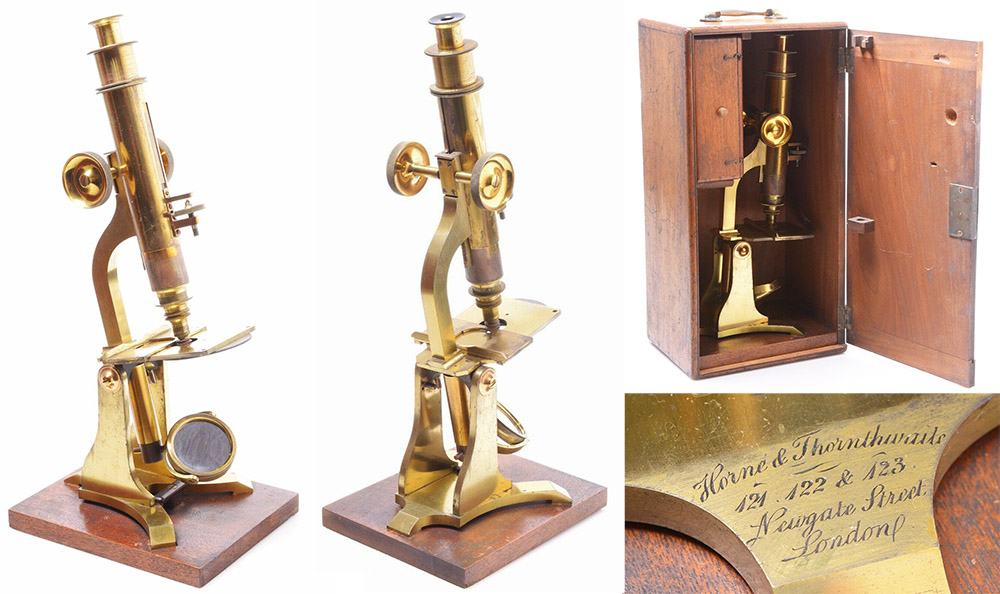
Figure 10.
Microscope by Horne and Thornthwaite, with address 121, 122, and 123 Newgate Street. Manufactured ca. 1856-1874. Adapted for nonprofit, educational purposes from an internet auction site.
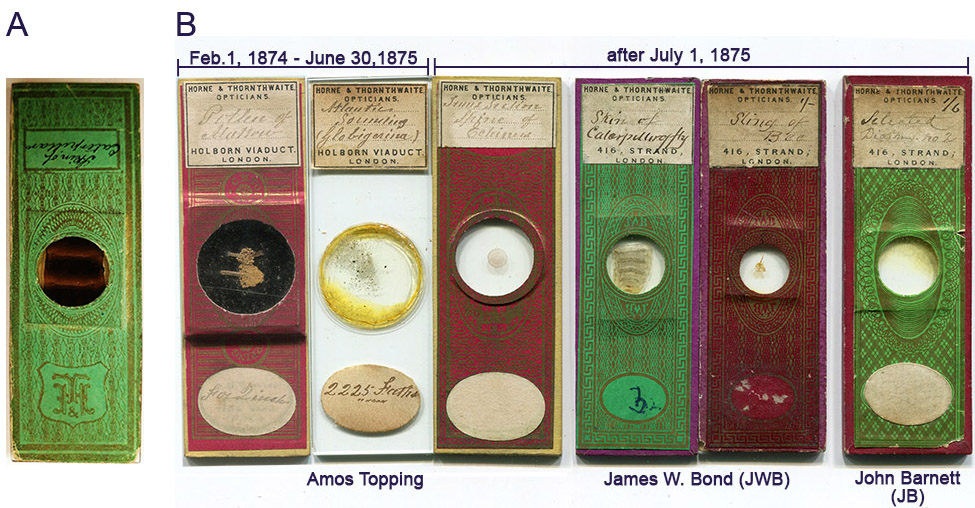
Figure 11A.
Examples of microscope slides that were retailed by Horne and Thornthwaite. A. A slide with cusomized paper, bearing the monogram "H & T". The actual maker of this slide is not known.
B. Several slides wwhose makers can be identified by their monogrammed cover papers and/or handwriting. Among their suppliers were some of the most renowned slide-makers of the time, including Amos Topping, James W. Bond, and John Barnett. Addresses on the labels date the slides’ production.
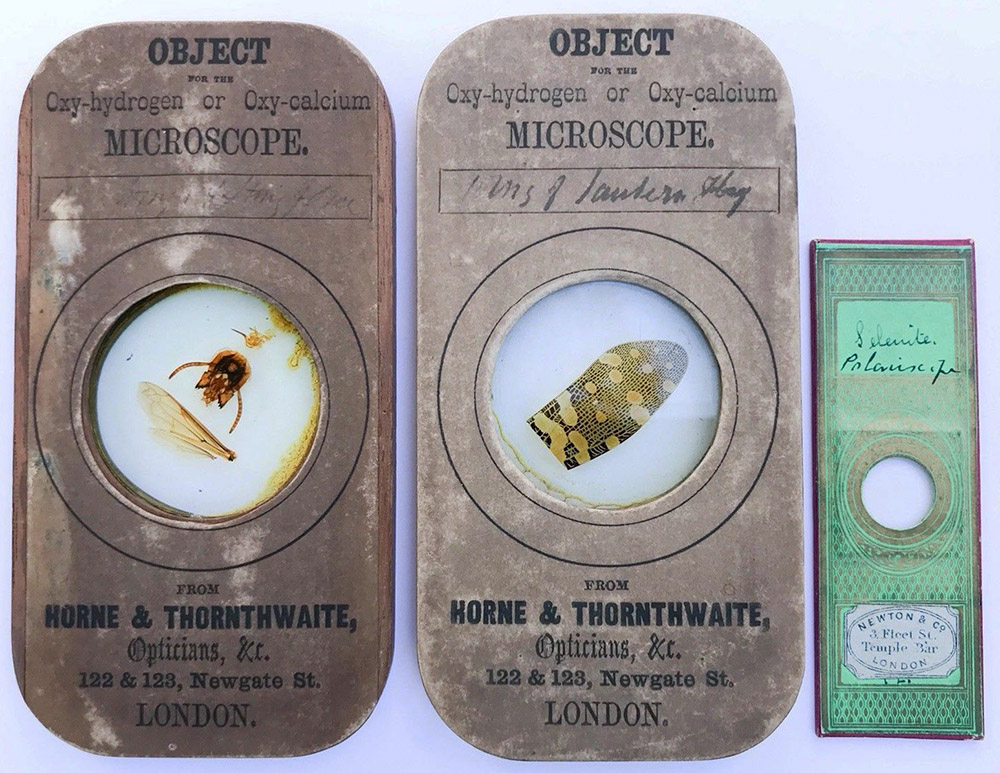
Figure 11B.
Two magic lantern slides that were retailed by Horne and Thornthwaite. They are made of wood, with balsam-mounted specimens. The handwriting is very likely that of James W. Bond, who was well-known for both his microscope and lantern slides. The address dates their production to between 1850 and 1874. A standard 1x3 inch slide is shown as a size comparison. Adapted for nonprofit, educational purposes from an internet auction site.
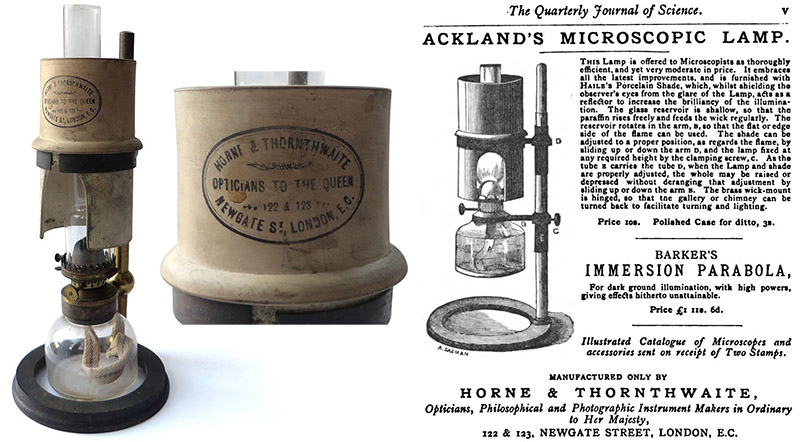
Figure 12.
A Horne and Thornthwaite lamp for illuminating microscopical work, with an 1872 advertisement that attributes its design to William Ackland. Adapted for nonprofit, educational purposes from an internet sale site.
Fallon Horne was born in early 1814 or late 1813, probably on the Isle of Thanet, Kent. He was baptized in Boughton Monchelsea, Kent, on January 28, 1814. His parents were named Richard and Margaret, and he had at least five siblings: brothers Richard, Edward, Herbert, and John, and sister Mary. Father Richard died in 1818, when only 41 years old, and mother Margaret died when she was 50, in 1827. Fallon was in his 44th year when he died, brother Richard died when 44, brother Edward died when 49, and brother John died when 15. In contrast, brother Herbert lived into his late 60s. The early deaths of so many family members, and the exception of Herbert, suggests a chronic, communicable disease such as tuberculosis. The early deaths of their parents undoubtedly placed financial stresses on Fallon and his siblings, and they likely were independently employed at very early ages.
Fallon followed a route to become a chemist. The 1841 census recorded Fallon as being a working chemist, living with a “druggist” and his family in Saint Mary Newington, Surrey. He was then 25 years old. The description of his occupation implies that Horne was skilled in that trade, possibly having undergone an apprenticeship with his landlord.
William Henry Thornthwaite was born on January 10, 1819. His father, William Craven Thornthwaite, was an ironmonger. The 1841 census states that William was then living with his employer, Edward Palmer, his family, and servants, at Palmer’s business premises, 103 Newgate, London. Both Thornthwaite, Palmer and another resident, Thomas Willatts, were listed as being “chemical and philosophical instrument makers”.
In 1843, William wrote one of the world’s first books on photography, titled Photographic Manipulation (Figure 13). The first edition, issued in May, 1843, quickly sold out, and a second edition was issued in July. Both were published by Edward Palmer. The author’s name was not listed, although the preface was initialed “W.H.T.” (Figure 13).
Edward George Wood was born on February 28, 1811, in Pentonville, London. His father, George, worked as a “carver”. A younger brother, George Smart Wood (1816-1882), became a partner in the Liverpool optical and scientific business of Abraham Abraham (~1799-1863), which George and his son operated into the twentieth century. In 1886, Edward and George’s heir, John, issued joint advertisements for their businesses (Figure 33).
Edward married Martha White on July 15, 1838, at Saint John’s, Hackney. He was recorded as being a “philosophical instrument maker”. The marriage suggests that Edward’s financial situation was relatively stable by that time. The 1841 census lists Edward, Martha, and a two year-old daughter, living in Islington, with Edward’s profession recorded as “machinist”. His parents lived close by, and three brothers (including George) were similarly recorded as being “machinists”.
Thus, all three men were professionally prepared when they took over Palmer’s business in August-September, 1844. They were experts in producing optical and scientific equipment, and chemical supplies for photography and other occupations.
For an unknown reason, Horne, Thornthwaite, and Wood opened their shop at 123 Newgate Street, although Palmer’s shop had been at 103 Newgate.
Shortly after opening their business, the partners issued a catalogue, “Horne, Thornthwaite, and Wood’s Illustrated Catalogue of Optical and Philosophical Apparatus, Containing upwards of Three Hundred Engravings of Apparatus, Illustrative of Chemistry, Hydraulics, Hydrostatics, Pneumatics, Frictional and Voltaic Electricity, Electro-Magnetism, Electro-Metallurgy, Optics, &c., &c., Manufactured and Sold by them at 123, Newgate Street, London”. The title is nearly identical to that of Edward Palmer’s 1840 catalogue, and probably contained many of the same items. An abridged, non-illustrated catalogue was inserted in books published by Horne, Thornthwaite, and Wood during 1845: William Thornthwaite’s “Guide to Photography” and Cornelius Varley’s “Treatise on Optical Drawing Instruments” (Figure 14). A two-page mini-catalogue was attached to the rear of their 1846 publication of Alfred Smee’s The Potatoe Plant, which included a drawing of an apparently original microscope design (Figures 2 and 15).
The partnership was also referred to as “Horne & Co.”, and appears to have been used interchangeably with “Horne, Thornthwaite, and Wood”.
In addition to scientific and photographic equipment and supplies, the firm was at the forefront of “medical galvanism”, i.e. the application of electricity for medical purposes. To accompany their battery-powered medical devices (and encourage their purchase), in 1846 they published “A Guide to the Correct Administration of Medical Galvanisms, and Companion to the Improved Electro-Galvanic Machines” (Figure 16). The author was James Herbert Horne, “general practitioner, L.S.A., Surgeon to the Dispensary for Diseases of the Skin, Soho, and member of the Westminster Medical Society”. Despite the surname, he does not appear to have been a relative of Fallon Horne. At this same time, a future business partner, William Ackland, described himself as a “medical galvanist”, and also wrote a book, Galvanism as a Remedial Agent.
In about 1850, the business expanded to include 121 Newgate Street (Figure 17). Further expansion into the intervening building, 122 Newgate, occurred around 1856. During following years, advertisements stated the address of 123 Newgate, but may or may not include either or both 121 and 122. This suggests that the main office/saleroom was at 123, while the other buildings may have held limited varieties of goods.
As did most other major British manufacturers and retailers, Horne, Thornthwaite, and Wood exhibited at the 1851 Great Exhibition of the Works of Industry of All Nations. Their entry lists, “Dissolving views. Transparency of the moon. Electrogalvanic machine, &c. for medical galvanism. Oxy-hydrogen microscope. Daguerreotype and calotype apparatus and chemicals. Agricultural drainage-levels, galvanometer, &c.” and “Smee's optometer, for ascertaining the refractory humours of the eye, and the required focus of spectacle glasses”. They were awarded a Prize Medal for their “camera with a double achromatic object glass, whose aperture is about 2 1/2 inches. The size of the picture is 8 by 7 inches. The frame allows of two papers being placed in at one time. The box is made to fold together, and is a fine specimen of beautiful, neat, mahogany work, with many good contrivances to keep out light. There is no speciality in the construction of the daguerreotype and calotype apparatus of these exhibitors, excepting a mode of iodizing and bromizing the plates, by sliders of great neatness; the exquisite workmanship of their several articles; and the general arrangements for their use in daylight. Some very fine specimens of chemicals used in the process of photography are also exhibited”.
The 1851 census provides indications that the business was doing quite well. Wood lived above the shop at 123 Newgate Street, with his wife and two sons, as well as two apprentice opticians (William Griffith and John Herman Powell), a boarder, and two domestic servants. Thornthwaite had married in 1849; he and his wife and 10 month-old son lived in Islington, with two domestic servants. An exception when compared to his partners’ upper-middle class lives, Horne boarded at a house on the Strand. Considering the likelihood that he had a chronic disease (as discussed above), Horne may have forgone marriage and an independent home in order to have someone take care of him for what turned out to be a short life (he died in 1858 when only 44 years old).
During the early 1850s, Horne displayed (and presumably sold) photographic images, such as “Youth and Age” (Figure 19).
The partnership of Horne, Thornthwaite, and Wood was dissolved in August, 1854. The business at 121/123 Newgate Street re-formed as Horne and Thornthwaite (Figure 20). E.G. Wood established a new business at 117 Cheapside (Figure 21).
Around this same time, a legal case had important ramifications on photography in England. William Fox-Talbot (1800-1877) had patented his calotype process of photographing on paper in 1841, and zealously guarded against professional photographers who used any method that resembled his calotype without paying a license fee. Martin Laroche (1814-1886) pushed back aggressively, leading to a lawsuit for copyright infringement. A Photographic Defense Fund was formed in January, 1855, with William Thornthwaite as Honourable Secretary. Other members included Fallon Horne, Edward Wood, microscope- and camera-maker Andrew Ross (1798-1859) , and the Treasurer of the Bank of England, Matthew Marshall (1791-1873). Both Thornthwaite and Ross testified for the defense of Laroche. The jury decided that Laroche had not infringed on Fox-Talbot’s patent.
At the 1855 Paris Universal Exposition, “Horne and Thornthwaite, 122 and 123 Newgate-street, London (exhibited) improved photographic apparatus and lenses, and philosophical instruments”. Edward Wood did not exhibit.
Advertisements from March, 1856, indicated that Horne and Thornthwaite had by then expanded to include number 122 Newgate Street (Figure 22).
Horne and Thornthwaite’s photographic division expanded to include professional production of photographs, capitalizing on the craze for personal cartes-de-visite (Figure 24).
Horne and Thornthwaite developed, patented, and marketed an anesthetic-delivering machine in 1857. Their device focused extreme cold on skin, gums, etc., a process they named “Congelation”. The pair wrote and published a book that described the machine, Chloroform Superseded in Dental Operations, by a New Method of Inducing Insensibility to Pain.
William Ackland became associated with Horne and Thornthwaite during the mid-1850s. In 1857, Ackland wrote How to Take Stereoscopic Pictures, which was published by Horne and Thornthwaite. Afterwards, Ackland was closely linked to the firm. At some point, Ackland became a partner in Horne and Thornthwaite. Ackland was a polymath; trained as a physician, he became a skilled optometrist and mechanical engineer. He was a major force in the company, providing eye examinations, manufacturing eyeglasses and optical equipment, and writing books.
Ackland was born in Buckland, Somerset. He trained in medicine at Charing Cross Hospital, and awarded a Licentiate in the Society of Apothecaries in 1846. As noted above, he set up as a “medical galvanist”, describing himself in an 1845 advertisement, “Mr. Ackland, formerly of Devonshire, but now residing at No. 8, Claremont-place, Pentonville, London, has made such extensive improvements in the Galvanic Battery that the galvanic fluid is now capable of being moderated in quantity and regulated in intensity, so as to render it one of the most beneficial remedies in nervous disorders and paralysis. His method of treatment is so successful as to remove disorders even after being given up as incurable by celebrated physicians. One case of St. Vitus's dance, in particular, we have heard of, which had been treated by some of our celebrated physicians without effect, but which Mr. Ackland cured in one month. We, therefore, confidently recommend every one afflicted to read Mr. Ackland's Pamphlet on Galvanism, which he forwards (free) to any one sending him a postage stamp". He published a book, Galvanism as a Remedial Agent, in 1847.
Ackland did far more than engage in questionable medical therapies. He invented important, precision devices. He exhibited in the 1851 London Exposition, in the same class as did Horne, Thornthwaite, and Wood (Philosophical and Surgical Instruments): “Entry 368 Ackland, W. 19 Dorset St. Portman Sq. inv. - Machine for the graduation of hydro-meters, thermometers, &c. Scales for an hydrometer, showing specific gravities and per centages”. Previously, gradations on hydrometers were established marking the float level at two or three densities of liquid, then filling in the gaps with evenly-spaced marks. Instead, Ackland mathematically determined what the float levels would be at other densities, and made his graduation-marking machine to accurately indicate those levels. His machine also had the novel feature of making every fifth division longer than the intervening four lines. Ackland was awarded a Prize Medal for this machine.
By 1852, Ackland had set up a scientific and medical equipment business, at 93 Hatton Gardens (Figure 25). He exhibited “hydrometers and alkalimeter, illustrating the application of Ackland's dividing machine” at the 1853 New York Exhibition of the Industry of All Nations
Ackland’s association with Horne and Thornthwaite came just before the death of Fallon Horne, which occurred on October 8, 1858. If Horne did die of a chronic disease, then his death may have been anticipated, so bringing in a new partner would make good business sense. The name Horne and Thornthwaite was retained, without acknowledging Ackland as an owner.
The 1861 census indicates the size of the Horne and Thornthwaite business at that time. Thornthwaite’s profession was described as “philosophical instrument maker, employing 25 men, 5 boys, 3 women”. He lived with his wife, five children, a maiden aunt, and three servants at 4 Willow Bridge, Islington. Thornthwaite’s wife died later that year, at the age of only 32. Ackland (“surgeon and optician”) lived at 19 Church Row, Newington, Surrey with his wife, two children, mother-in-law, and a servant. Wood lived at his business address, 117 Cheapside, with his wife, three children, an apprentice, and a servant.
During 1861, William Crookes arranged for an optical instrument to be created for Charles H.G. Williams. Crookes would have preferred to engage William Darker to make the device, but settled for Horne and Thornthwaite. He wrote to Williams on February 28, 1861, “I have had a long consultation with a very intelligent instrument maker … Please say whether the above will suit your views … I will then set the maker to work at once. Darker is by far the best man to go for anything of the sort but he keeps people waiting for 18 months or 2 years!” Crookes wrote again on March 7, “Mr. Ackland at Horne and Thornthwaite’s is making the apparatus. I saw it yesterday. It will be finished in about a week now”. The initial version was not as anticipated, as stated by Crookes in an April 1 letter, “First about your apparatus, it came in due time and I devoted an evening to its study. It was not so perfect as I think it could be made, so I took a sheet of paper and found every possible fault with it, stating the best remedy … It is a great bore that it cannot be made right at first”. Improvements were quickly made, although Ackland overthought the project and introduced new errors, as described in Crookes’ April 4 letter “I devoted some hours yesterday afternoon, at Horne & Thornthwaite’s, to adjustment of your apparatus. The long paper of faults which I sent them last week has been attended to and I found a considerable improvement; altho’, they had tried to be too clever and had so taken the trouble to regrind all the lenses and put in achromatics (and as we want all the colour possible this is not only a needless expense, but is positively injurious”. Several day slater, on April 13, Crookes wrote “Respecting your apparatus, do not keep it unless you are thoroughly satisfied with it. Send it back and Ackland will easily get rid of it to someone else … and will make you a better one, or he will do anything in the matter you propose as to altering it &c.”. Williams does not appear to have kept the equipment. Nonetheless, Horne and Thornthwaite soon advertised that they were manufacturing “Crookes’ Spectrum Apparatus” (Figure 26).
For some years, Ackland retained his own business to some extent. The catalogue of the 1862 London Exposition lists, “Ackland, W. 19, Church-row, Newington Butts - Dividing engine and instruments divided thereby”. He earned an Honourable Mention “for the accurate construction of his straight line dividing engine”. This may have been an attempt to market his invention, which had been developed independently of Horne and Thornthwaite, so there was no reason for him to share either credit or profit. Horne and Thornthwaite displayed, “Rhumkorff’s induction coil, spectrum apparatus, meteorological instruments, chemical apparatus, microscopes, &c.”, also earning an Honourable Mention “for general excellence in articles exhibited”. E.G. Wood exhibited “optical, philosophical, and photographic instruments”, and earned an Honourable Mention “for good workmanship in philosophical instruments”.
The 1862 London Exposition Catalogue also noted that Edward Wood had recently moved from 117 Cheapside to 74 Cheapside (Figure 27). He remained at that location until his death.
In 1867, Horne and Thornthwaite published Hints On Spectacles: When Required And How To Select Them, written by William Ackland. Advertisements from that time onward directed customers to see Ackland for eye examinations (Figure 28). He was, by then, an experienced optometrist.
As time progressed, William Thornthwaite reduced his involvement with the operations of Horne and Thornthwaite. He became an officer of the Gresham Life Assurance Company during the 1860s, and its Chairman in 1869. He retained that office until his death. The 1871 census still listed him as being involved with Horne and Thornthwaite, as an “optician master employing 10 men and 3 boys”, but, by 1881, he was a “retired optician”. Ackland became the dominant partner of the company, and a large proportion of advertisements prominently featured his name (Figures 12, 28, 29, and 30).
Ackland developed a simple, effective, and popular selenite device for polariscope work in 1872. I have not located an illustration of this, but it was described as, “Mr. Ackland (Horne & Thornthwaite) has just designed and brought out a very clever and handy selenite stage, which will replace elaborate and expensive contrivances now in use for obtaining a variety of tints for polariscope objects. Mr. Ackland found that a neutral tint like that of Newton's rings midway between the violet of the second wave and the indigo of the third wave, had an extremely delicate and advantageous action, producing remarkably gorgeous colours with suitable objects. He prepares selenite films of the exact thickness, and microscopists can be supplied with an apparatus of three or four rotatory films at a very moderate price”.
Horne and Thornthwaite moved from Newgate Street to 3 Holborn Viaduct at the beginning of February, 1874. That location lasted for a little over one year. At the beginning of July, 1875, the business moved to 416 Strand, a busy location near to the popular Adelphi Theatre (Figures 31, 41, and 42).
As noted above, William Thornthwaite had retired from the optical business by 1881. His son, William Jr., was listed in that year’s census as being an “optician”, implying that he was involved with operating Horne and Thornthwaite. Edward Wood, and his son Augustus, were both listed as “optician masters”, living in their shop at 74 Cheapside (along with Augustus’ wife and children, and two servants).
Horne and Thornthwaite was dissolved on December 24, 1883 (inexplicably, this was not announced until February 6, 1885). At that time, the partnership had consisted of William Thornthwaite, William Ackland, and Francis William Barnes (Figure 32). Nothing more is known about Barnes – I have not located an optician, photographer, or instrument maker of that name, so he may have been a silent investor. Since William Henry Thornthwaite was reported to have been retired in 1881, the “William Thornthwaite” on the business record may have been his son.
The business quickly reformed as Horne, Thornthwaite, and Wood, a partnership that included Edward Wood and William Ackland. Wood retained his shop in Cheapside, and advertisements frequently gave both business names and addresses (Figure 33). Some advertisements also gave the address of Wood’s nephew’s business in Liverpool (Figures 33 and 34).
Publications that supported their products remained important components of the firms. In 1885, Ackland published his ninth edition of Hints on Spectacles, and a new book, Directions for Using Ackland's Improved Optometer and Optical Calculating Rule. For many years, Ackland had been Horne and Thornthwaite’s diagnostic optometrist. The latter book was intended to educate others in the art, and to sell the diagnostic devices he had invented. Also in 1885, Edward Wood’s son, Augustus, wrote Magic Lanterns: How Made and How Used. With Practical Hints to Unpractised Lecturers. Soon afterward, Augustus published A Photograph and How to Take it (Figure 34).
The 1891 census shows that the partners and ex-partner enjoyed comfortable lives:
William Thornthwaite was Chairman of his life insurance company. A widower since 1861, William lived at 14 Highbury Hill, Islington, with his sons and daughters. His second son was named James Falon Thornthwaite, in memory of his old partner. Eldest son William Jr. was a Director of the company, and lived with his father and siblings along with his wife and baby son. The house also held a cook, a parlor maid, a house maid, an under-housemaid, and a nurse maid.
Edward Wood lived at 74 Cheapside with his son, Augustus, daughter-in-law, and three grandsons (Edward’s wife had died during the 1860s). The youngest grandson, Leopold, would eventually take over the Wood business. The household also included a cook and general domestic servant.
William Ackland lived at 19 St. Luke’s Road, Clapham, with his wife and unmarried daughter. They were assisted by a domestic servant.
In addition, two of Horne and Thornthwaite’s employees, John and William Overstall, lived with their parents and sister at 24 Alexandra Road, South Hornsey.
The firm of Horne, Thornthwaite, and Wood dissolved for a second time during October, 1893. This was chronicled by their advertisements: The English Mechanic and World of Science ran ads from Horne, Thornthwaite, and Wood paired with E.G. Wood until October 6, but E.G. Wood alone from October 27 onward and a newly formed Horne and Thornthwaite after November 10. The E.G. Wood operation may have been run by Edward Wood but, considering his advanced age, it is more likely that Augustus maintained the day-to-day business. This iteration of Horne and Thornthwaite consisted of William Ackland and the Overstall brothers.
William Henry Thornthwaite died on February 20, 1894, at his home. He left an estate of £11731 16s 10d.
William Ackland died on March 30, 1895, leaving an estate of £1130 14s 7d. The British Journal of Photography wrote, “It is only the other day since we were conversing with Mr. William Ackland, who then appeared in good health, and it is still later since Mr. Ackland was the recipient of the highest gift which it was in the power of the Council of the Royal Photographic Society to bestow, he being elected an Honorary Fellow of the Society. This is a distinction to which, from his long connexion with photography and with the Society, Mr. Ackland was well entitled. He connected himself with the firm of Horne & Thornthwaite nearly forty years ago, when their premises were in Newgate-street, he being the director of their optical works, and he continued, mainly in this capacity, and in particular as consulting occulist in the Strand establishment of the firm up till his removal by death, which took place on Saturday last, the 30th ult. Mr. Ackland was much respected by all with whom he came in contact, and his absence will be felt at the photographic societies and clubs of which he was a member. He was a clever mathematician and a good photographer, and, in the course of his life, wrote several pamphlets facilitating the practice of the dry processes of pre-gelatine days. His latter-day hobby seemed to lie in the direction of improving equatorial stands and reflecting telescopes, of which several, displayed in Horne & Thornthwaite’s window and shop in the Strand, attest his success in this direction”.
Edward Wood died on January 11, 1896, leaving £1304 2s 4d.
Prior to Wood’s death, his business reoriented to electrical work. This was announced in The Electrical Engineer in 1895, “Messrs. Wood and Co , of 74, Cheapside, London, EC , have established a branch as electrical engineers for the carrying out of complete electric light and power installations. Mr. L.A.S. Wood is the consulting electrician”. Wood continued to sell microscopes and other such items, however, as evidenced by an 1897 advertisement (Figures 36 and 37), and a 1900 catalogue of binoculars and telescopes.
Upon Ackland’s death, the Overstalls became sole owners of Horne and Thornthwaite. John Overstall was born on September 17, 1867, in Finsbury region of London. William Thomas Overstall was also born there, during December, 1869. Their father was a cashier in a bank. Both brothers were trained in the manufacture of optical and scientific equipment: an 1898 note on William Overstall stated that he began an apprenticeship with E.G. Wood in 1885. Elder brother John presumably served a similar apprenticeship. The 1891 census listed 23 year-old John as a “mathematical instrument maker’, and 21 year-old William as an “optician assistant”. Both joined the British Astronomical Association in 1894, John from the site of the Horne and Thornthwaite business in The Strand, and William from their parents’ home.
The Overstalls were innovative manufacturers. For example, an 1897 edition of Knowledge reported, “Messrs. Horne and Thornthwaite have put upon the market Overstall's patent driving clock, a piece of apparatus suited for equatorial telescopes. It has, however, been designed principally for small telescopes, mounted either on a tripod stand or on the usual pedestal, and it involves but a small outlay, so that amateurs with limited means may enjoy the advantages of a hitherto inaccessible auxiliary, chiefly, the prohibitive cost of the ordinary driving clock. The right ascension circle is driven round by a simple weight (about three or four pounds), which directly actuates a screw or worm gearing with the toothed rim of the right ascension circle, and an adjustable weight serves to balance instruments of various sizes. Such an arrangement brings within the reach of the amateur a vast field of useful investigation, for, with the aid of the simple camera and spectroscope, celestial photography can be studied with reasonable hope of doing something of more than passing interest, even with a telescope of no more than three inches aperture”.
William Overstall was awarded a diploma by the Spectacle Makers' Company in 1898. John had previously passed that examination. A write-up in The Photographic Dealer stated, “Mr. William T. Overstall is the junior partner in the firm of Messrs. Home & Thornthwaite, Opticians to the Queen, 416 Strand. He is twenty-nine years of age, and of those years thirteen have been spent in the optical trade. Educated at the Cowper Street Schools, he was apprenticed in 1885 to Mr. E. G. Wood, of 74 Cheapside, and after the expiration of his apprenticeship remained with the same firm until 1893, when his brother (who has also passed the Spectacle Makers' Company's examination) and he became partners in the business of Messrs. Horne and Thornthwaite, with the late Mr. W. Ackland, who had built up a great reputation for skill in remedying defective sight. He has always, but especially during the last few years, given special attention to the eyesight, and the success he has met with bears out thoroughly the verdict of the Spectacle Makers Company's examiners”.
William Overstall married on November 8, 1902, to Kathleen Morris. The following summer, on June 13, 1903, John Overstall married Kathleen’s younger sister, Jessie. The two couples then lived close to each other, William and Kathleen at 60 Greenham Road, Hornsey, and John and Jessie at 64 Greenham Road.
The Overstalls dissolved the Horne and Thornthwaite partnership during 1911. John departed Liverpool on March 11, 1911, aboard The Montrose, headed for New Brunswick, Canada. His Canadian arrival record states that he had been an optician, but intended to be a farmer in British Columbia. William and his wife and children, along with John’s wife and children, and the brother’s sister, arrived in Quebec on the Empress of Ireland on June 23, 1911.
John Overstall died on June 10, 1941, in Matsqui, British Columbia. William Overstall died on January 27, 1957, in Victoria, British Columbia.
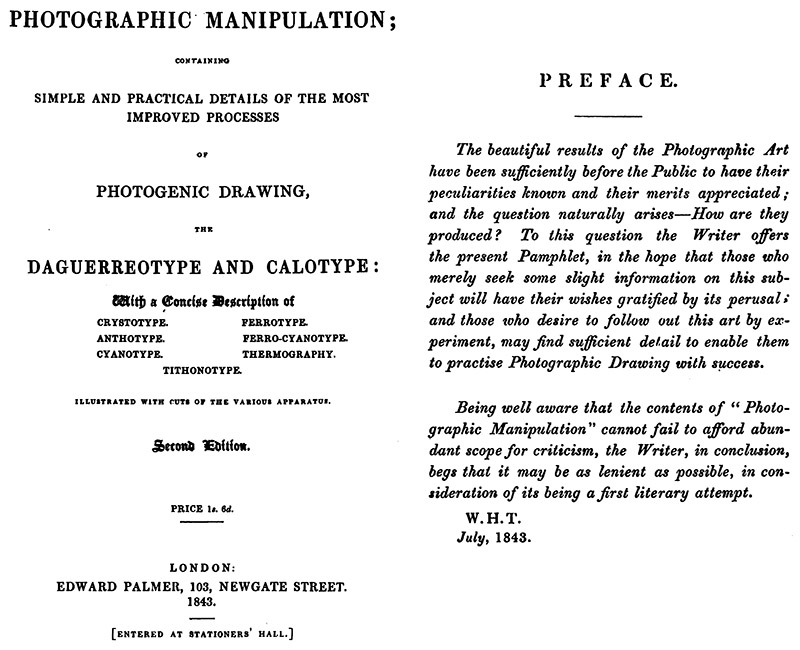
Figure 13.
Title page and preface from William Henry Thornthwaite’s 1843 book, ‘Photographic Manipulation’, second edition. It was published by his employer, Edward Palmer, and the only indication of Thornthwaite’s authorship is his initials in the preface. Priced at 1 shilling 6 pence, the book was described by ‘Mechanics Magazine’, “Mr. Palmer, of Newgate-street, who has taken so prominent a lead among instrument makers in all that relates to the modern arts of electro-metallurgy, photography, and glyphography, (the last an invention of his own, of which we shall presently take an early opportunity of giving our readers some account,) has just published a most needed, very cheap, and very useful little work under the above title. It is stated to be the ‘first literary attempt’ of the writer, and, so far as ‘literary’ talent has any thing to do with the matter in hand, is creditable enough to his pen; but the real value of the work consists in its being a plain and correct compendium of the elementary information necessary for the guidance of a person desirous of cultivating the photogenic art, drawn up from authentic sources by an intelligent hand, under the superintending eye of one of its most zealous and skillful practical cultivators, Mr. Palmer”.
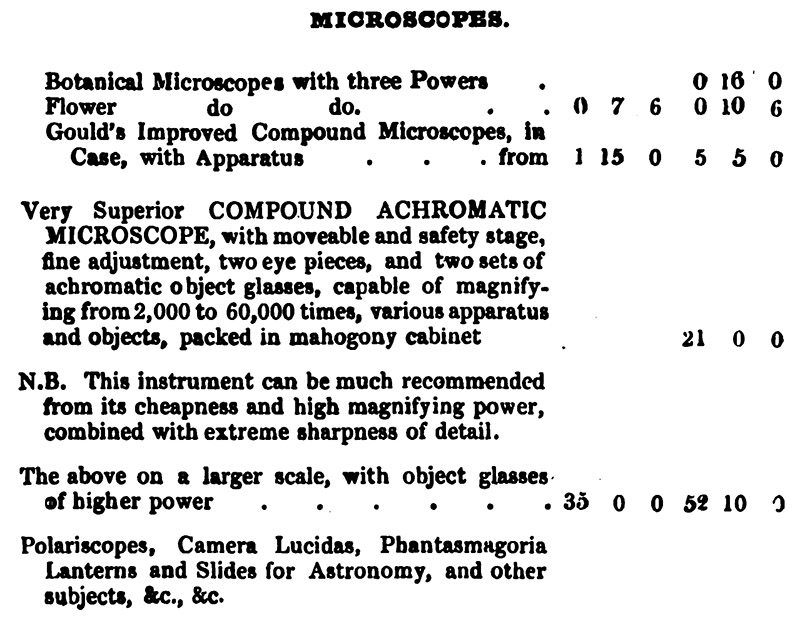
Figure 14.
Description of microscopes offered by Horne, Thornthwaite, and Wood in 1845, from an 11-page mini-catalogue bound inside Henry Thornthwaite’s 1845 book ‘A Guide to Photography’.
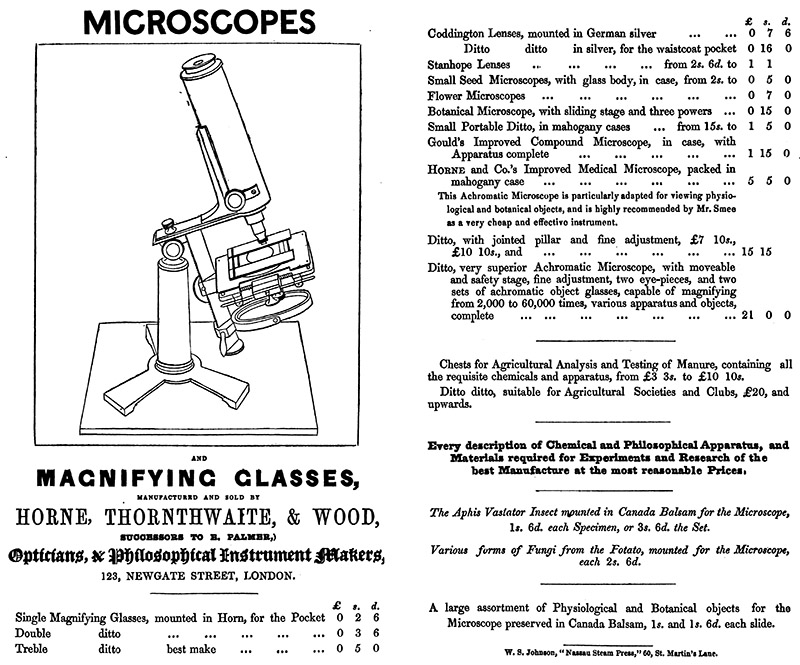
Figure 15.
Microscopes, magnifiers, and prepared microscope slides that were manufactured and retailed by Horne, Thornthwaite, and Wood in 1846. The two pages were included in the back of Alfred Smee’s ‘The Potatoe Plant’.
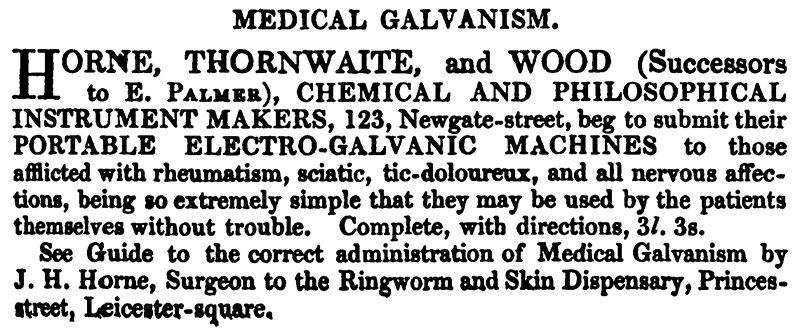
Figure 16.
An 1846 advertisement for Horne, Thornthwaite, and Woods’ medical electrical machines, and the book they published on the devices’ use. Author James H. Horne is not known to be related to Fallon Horne.
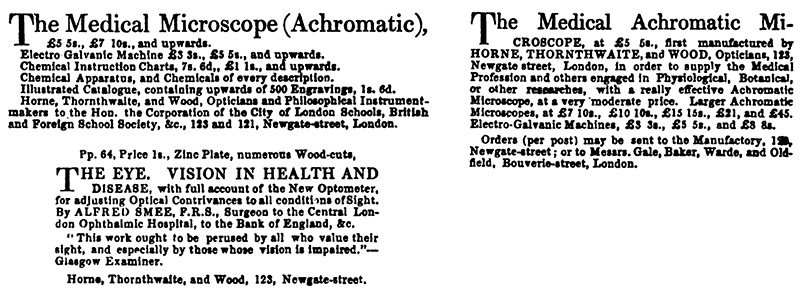
Figure 17.
1850 advertisements from ‘The Medical Times’. These are the earliest known records of the firm’s expansion to include 121 Newgate Street. They expanded further to include 122 Newgate around 1856. Throughout later years, advertisements may or may not include 121 and/or 122, suggesting that 123 Newgate was the main saleroom and/or that certain addresses featured different items.
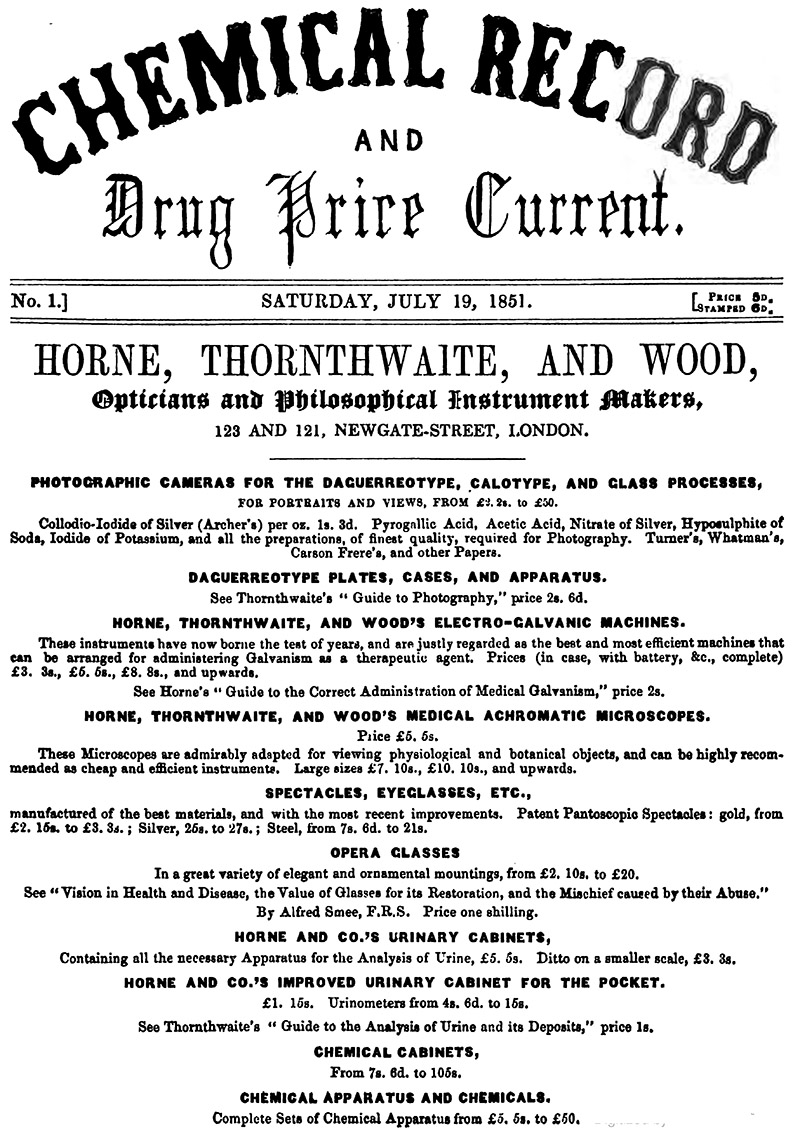
Figure 18.
An 1851 Advertisement from ‘Chemical Record’.
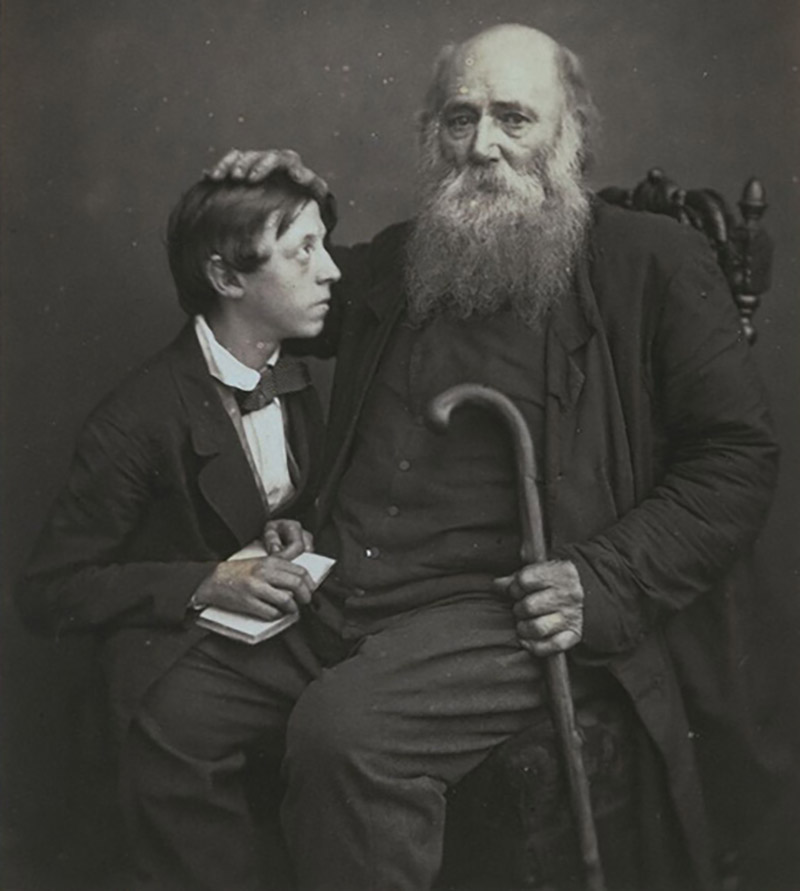
Figure 19.
“Youth and Age”, photograph by Fallon Horne. Adapted for nonprofit, educational purposes from The National Gallery of Canada, http://www.gallery.ca/en/see/collections/artwork.php?mkey=22340.
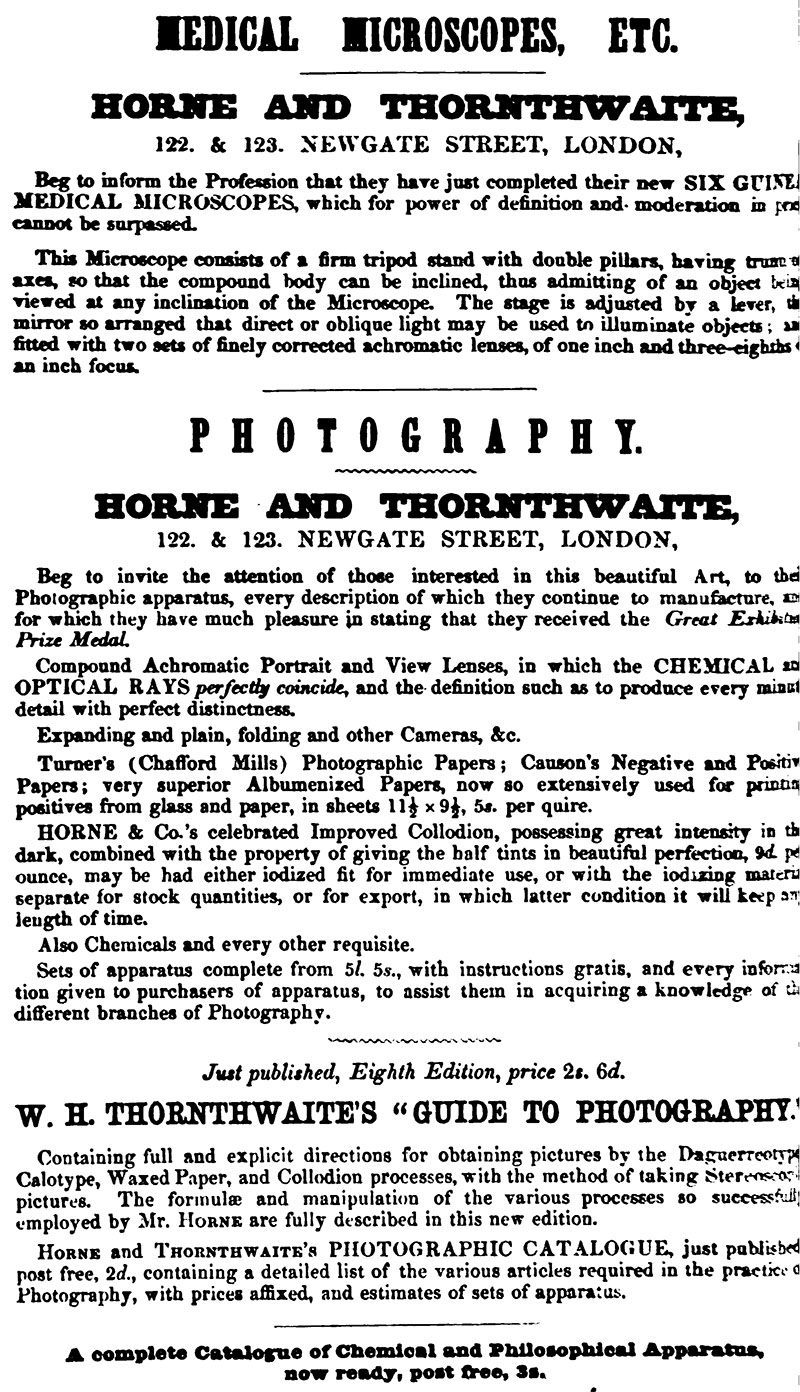
Figure 20.
An 1855 advertisement for Horne and Thornthwaite, from Arthur Hill Hassall’s ‘Food and Its Adulterations’. The partnership of Horne, Thornthwaite, and Wood was dissolved in August, 1854, with Horne and Thornthwaite forming a new partnership and Wood going alone (see Figure 21).

Figure 21.
An 1855 advertisement for E.G. Wood, from ‘Notes and Queries’. Wood probably had as much right to claim credit for the 1851 London Exposition prize as did his former partners.
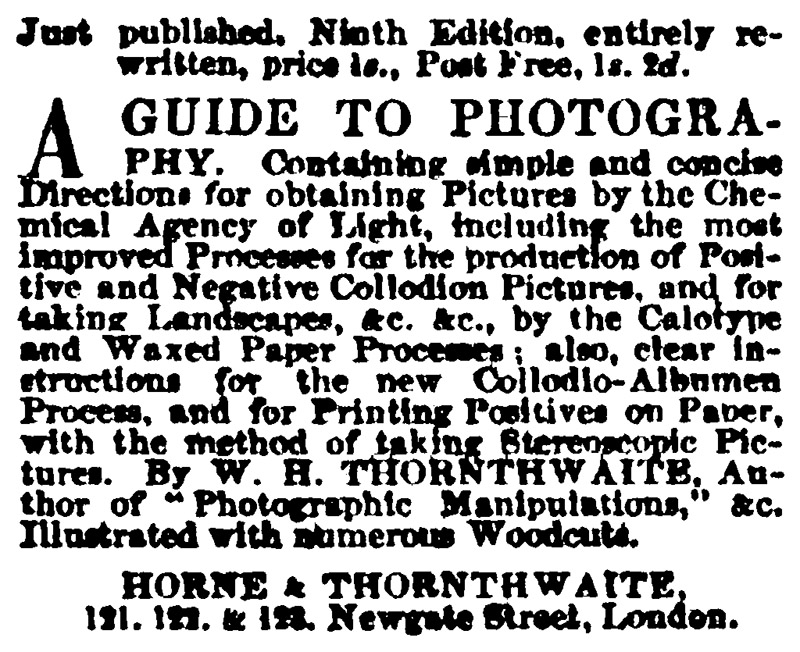
Figure 22.
A March 15, 1856 advertisement from ‘Notes and Queries’, indicating that Horne and Thornthwaite had by then expanded to occupy 122 Newgate Street, in addition to numbers 121 and 123.
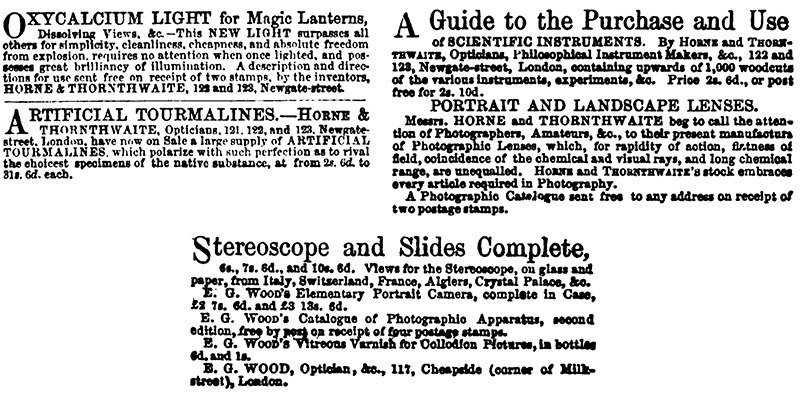
Figure 23.
Advertisements from 1857.
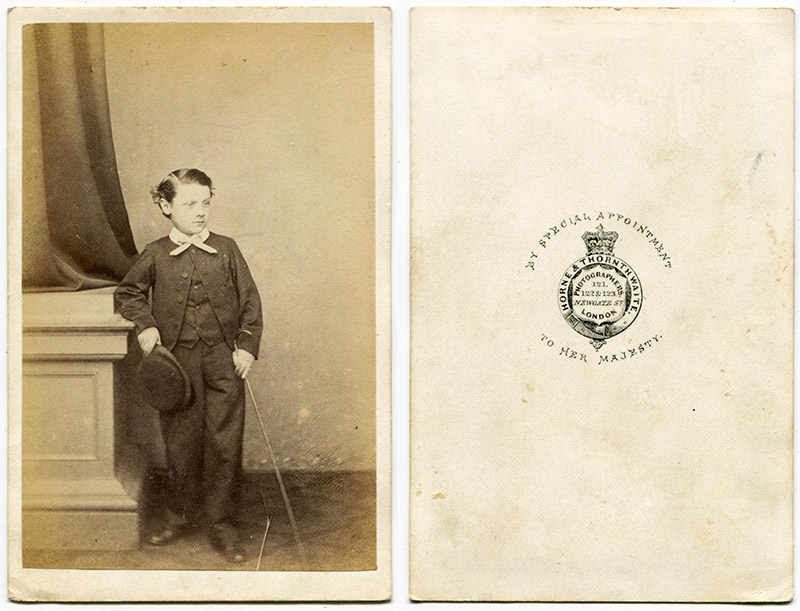
Figure 24.
A carte-de-visite (CDV) photograph, by Horne and Thornthwaite. The inclusion of 122 Newgate Street indicates production after 1865, but before the move to Holborn Viaduct in 1874.
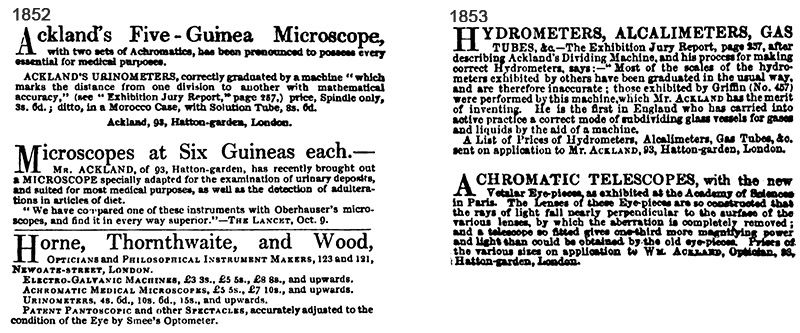
Figure 25.
Advertisements from William Ackland for his optical and scientific business at 93 Hatton Garden. He may have manufactured the microscopes and telescope that he sold, but was just as likely to have brought them in from wholesale manufacturers. One of Ackland’s 1852 ads was coincidentally printed adjacent to an ad from Horne, Thornthwaite, and Wood.

Figure 26.
An 1861 advertisement from ‘Chemical News’. In March of that year, William Crookes ordered this device, intended for Charles Williams, although it did not meet Williams’ expectations and he rejected it. This advertisement may indicate that Horne and Thornthwaite decided to mass-produce the device anyway, or it may be an attempt to unload the rejected apparatus.
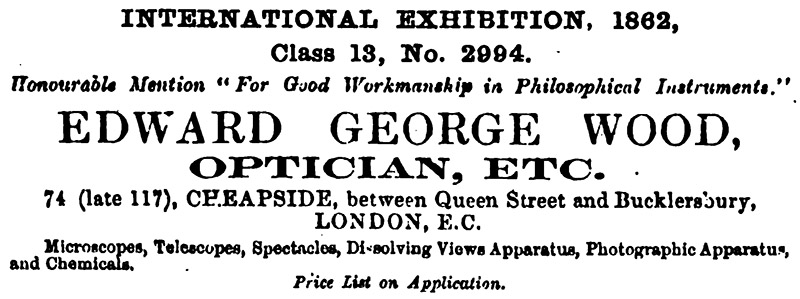
Figure 27.
An 1864 advertisement for Edward Wood, from ‘The Chemical News’. He moved from 117 to 74 Cheapside in late 1861 or early 1862.
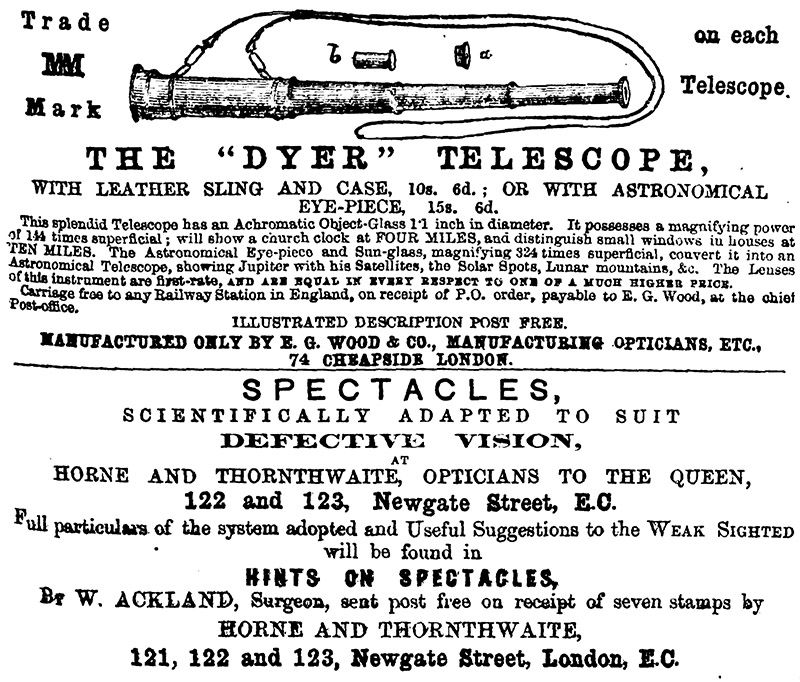
Figure 28.
1867 Advertisements from ‘The English Mechanic’. During that same year, William Ackland wrote ‘On Spectacles: When Required And How To Select Them’, published by Horne and Thornthwaite.
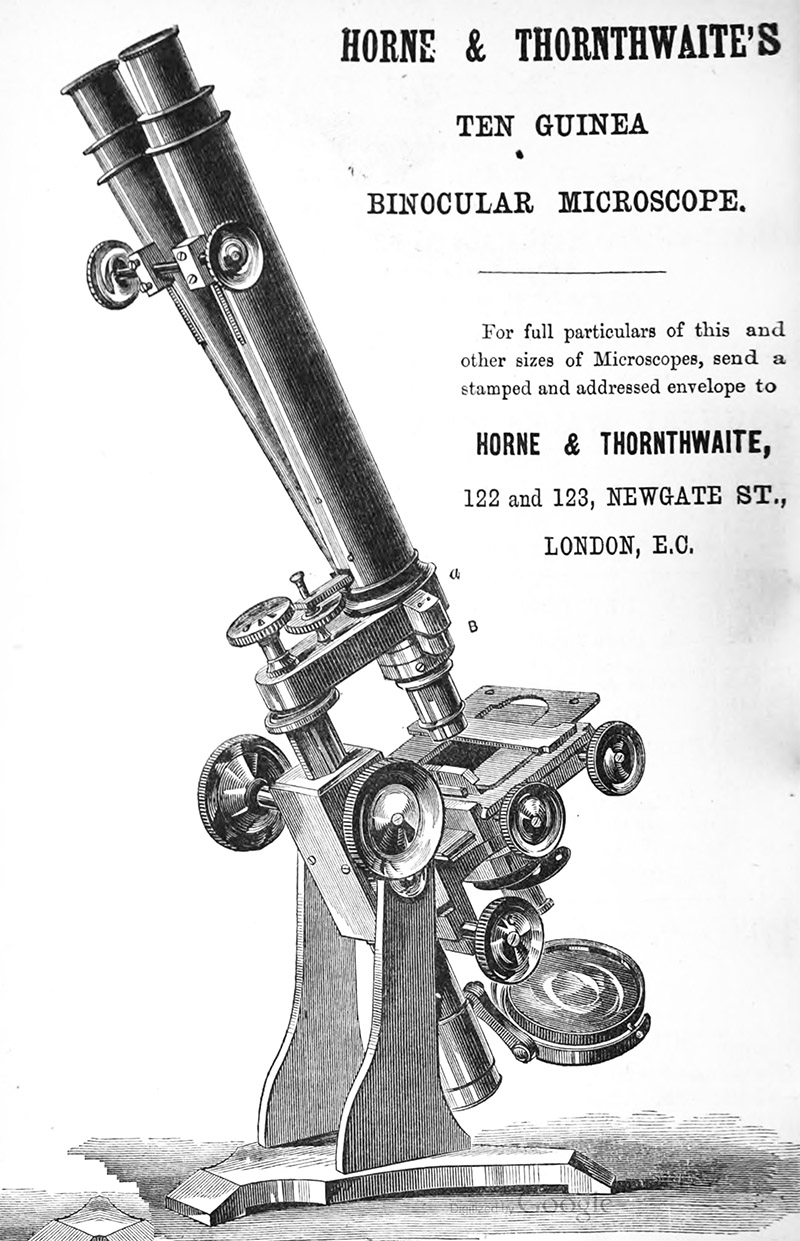
Figure 29A.
Advertisement from Mrs. Ward’s ‘The Microscope’, 1869.
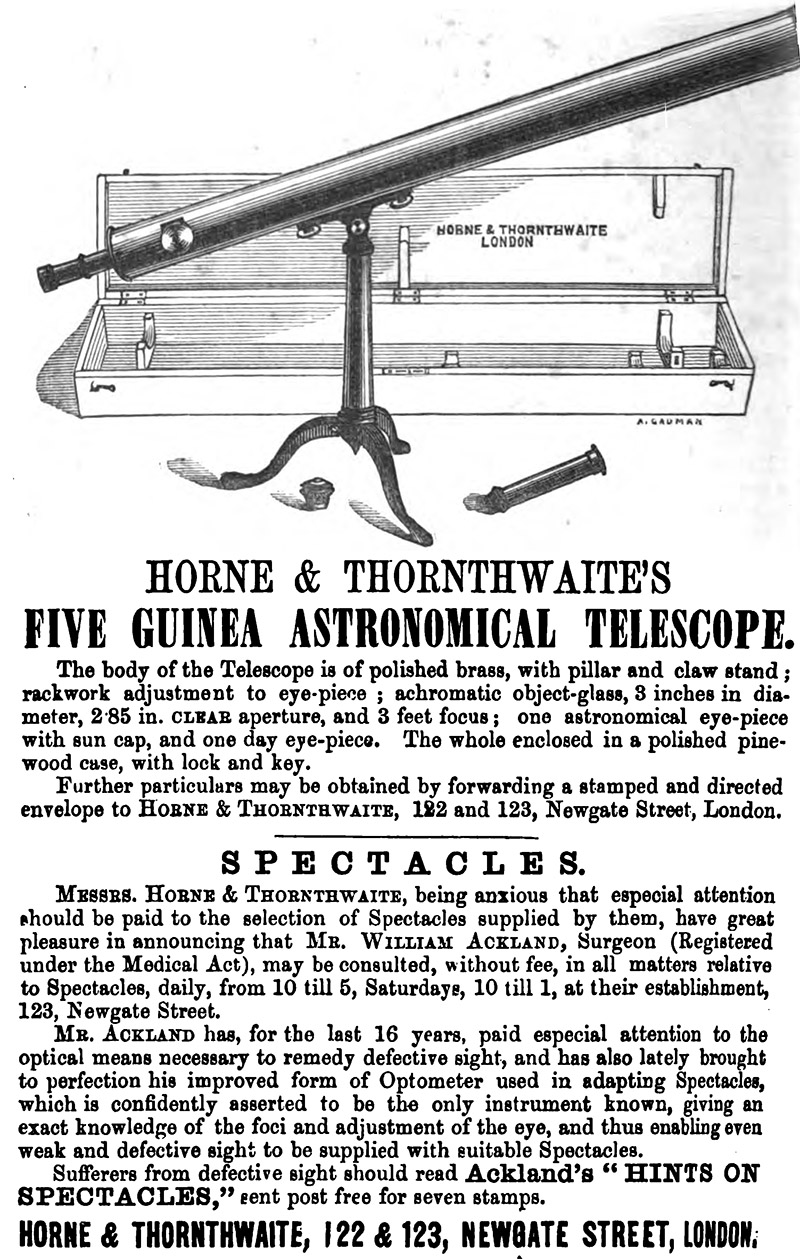
Figure 29B.
Advertisement from Mrs. Ward’s ‘The Telescope’, 1869.

Figure 30.
From ‘The Lancet’, 1874.
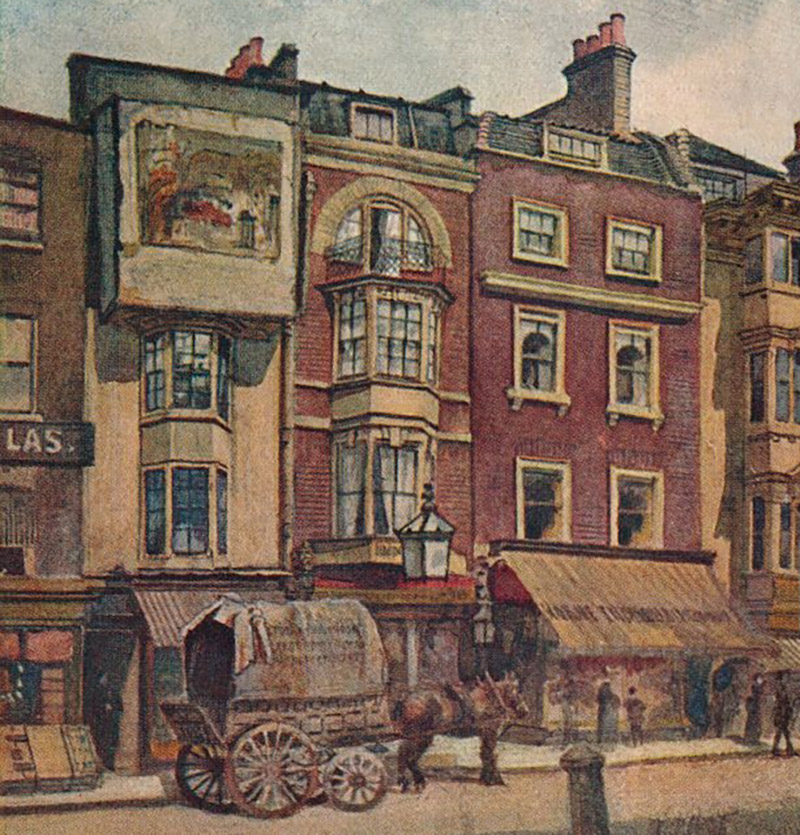
Figure 31.
A painting of The Strand, showing the Horne, Thornthwaite, and Wood premises at number 416, probably ca. 1885. Theirs is the red building on the right, with the large awning. The business name is printed on the awning.
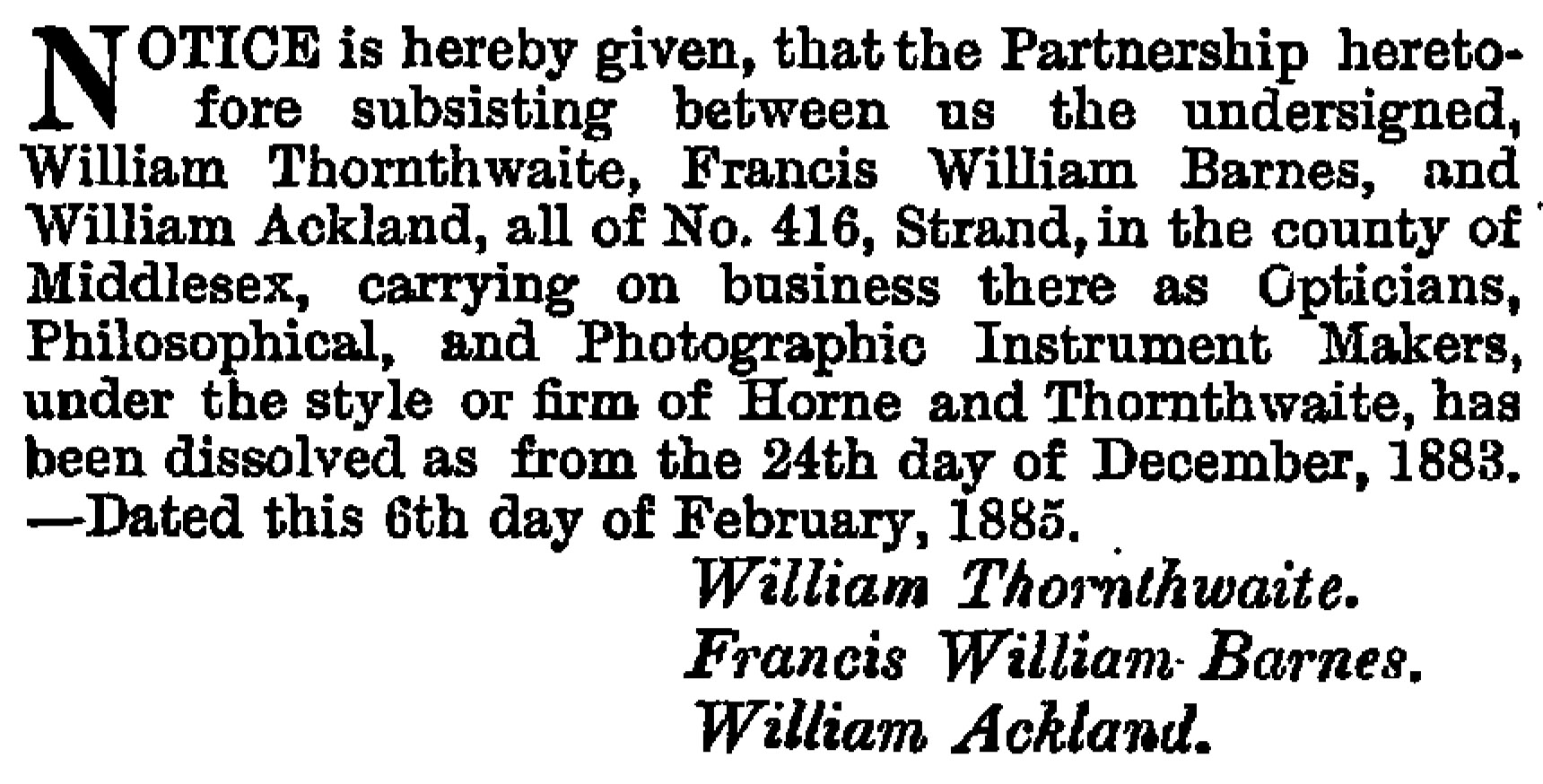
Figure 32.
Announcement of the dissolution of Horne and Thornthwaite, 1883/1885.
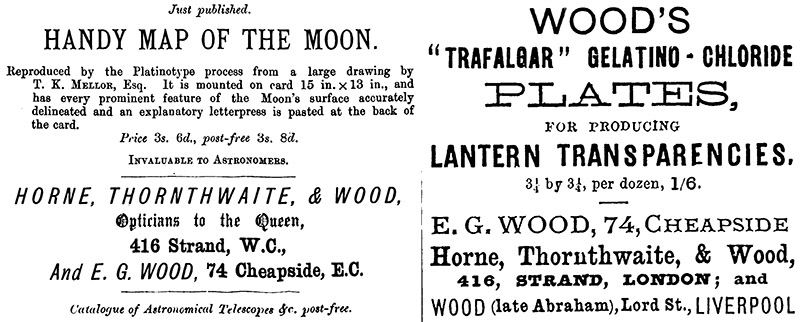
Figure 33.
Advertisements from 1886, after the re-formation of Horne, Thornthwaite, and Wood. Edward Wood retained his shop at 74 Cheapside. On occasion, their advertisements included the Liverpool business of Edward Wood’s nephew, John (son of George Wood, who died in 1882).
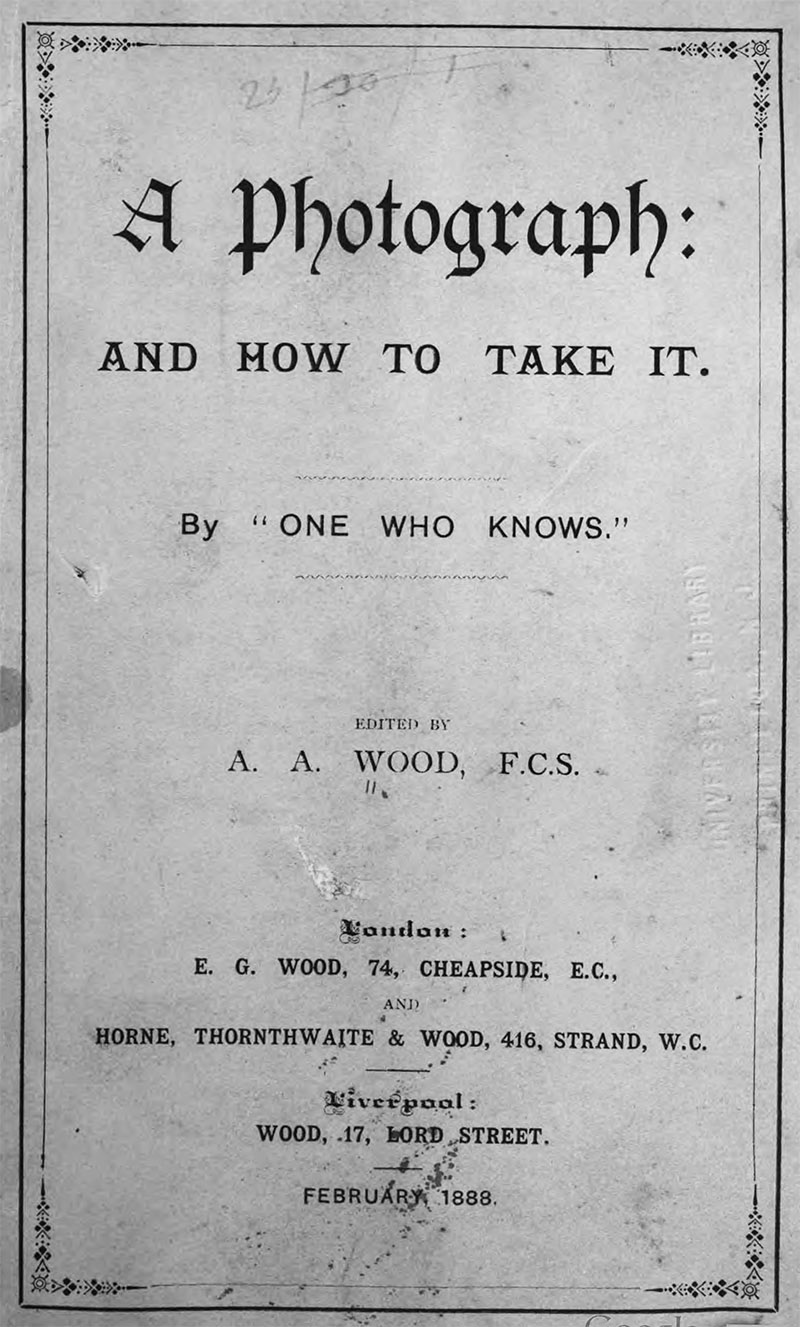
Figure 34.
The cover of Augustus Wood’s 1888 ‘A Photograph: and How to Take It”. It was available from both of Edward Wood’s London business, and from nephew John Wood’s Liverpool business.
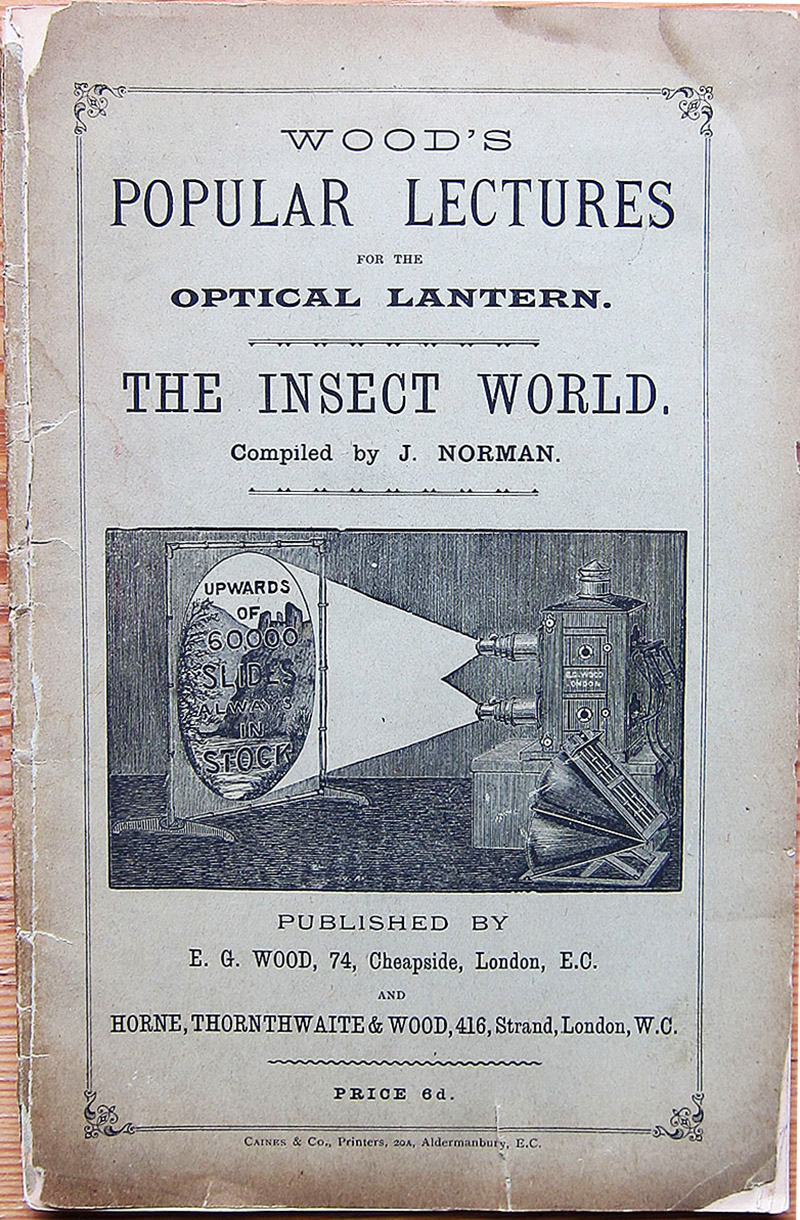
Figure 35.
A catalogue of lantern slides on “The Insect World”, offered by E.G. Wood and by Horne, Thornthwaite, and Wood. That combination of business names indicates production after 1885. It is possible that the collection was assembled by microscope slide-maker John T. Norman (1807-1893), who was an enthusiastic entomologist.
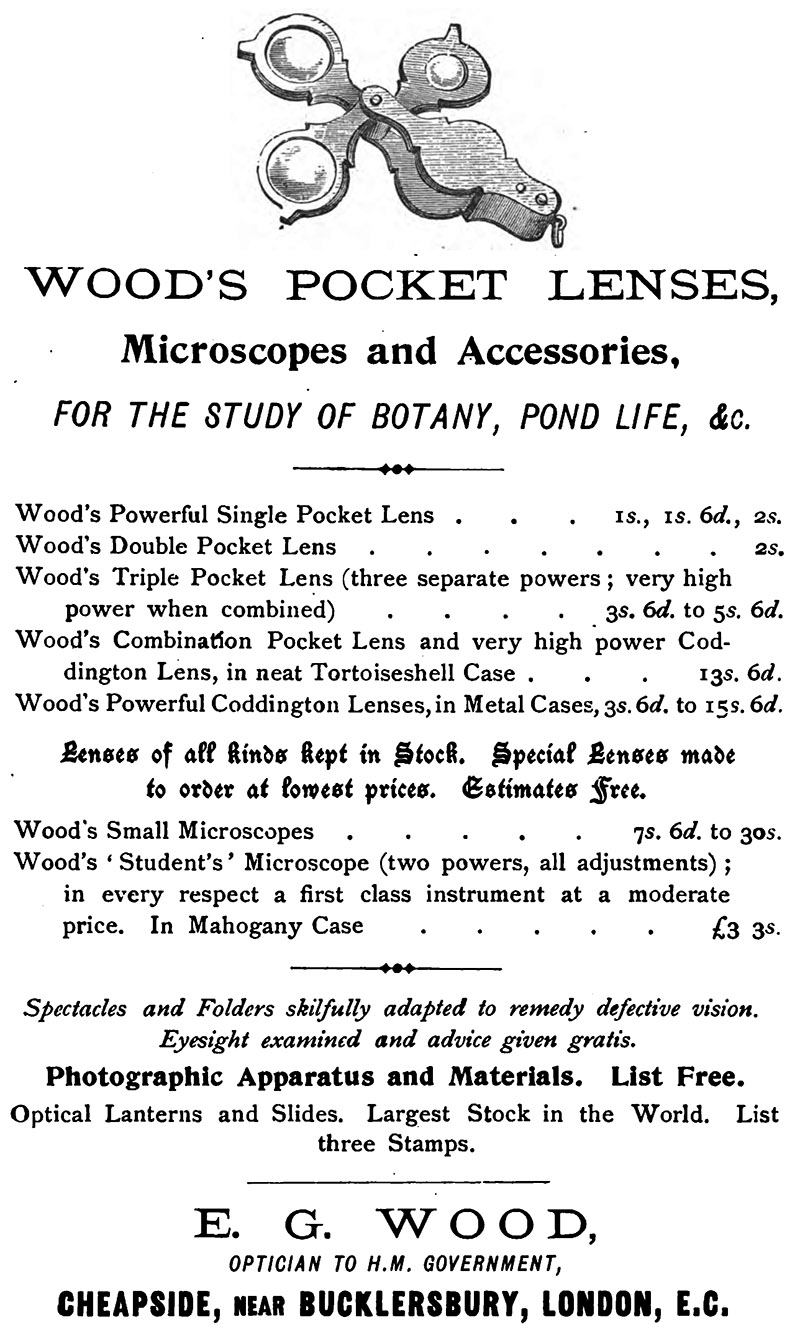
Figure 36.
An 1897 advertisement from Henry Scherren’s ‘Through a Pocket Lens’, indicating that the successor to Edward Wood continued to sell microscopic equipment.
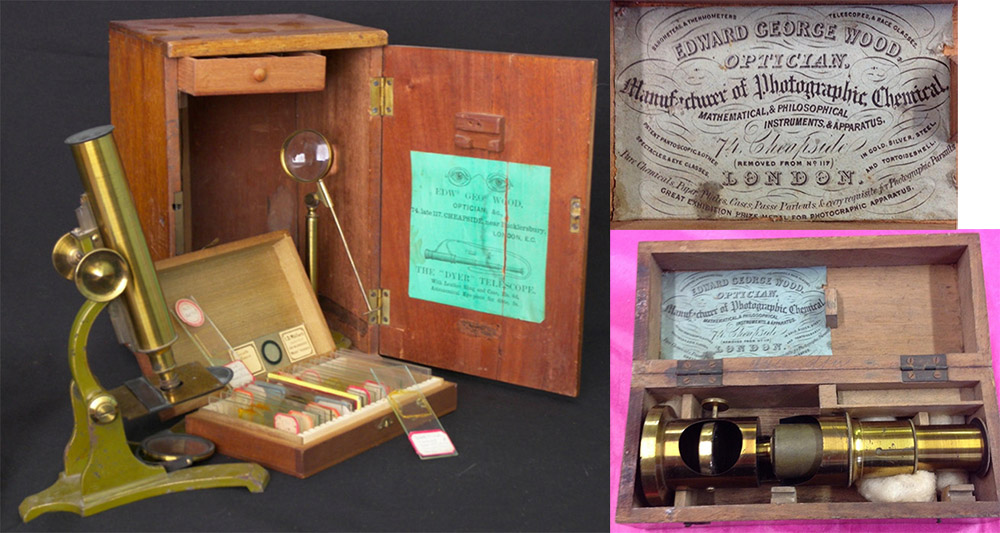
Figure 37.
Two microscopes that were retailed by E.G. Wood during the late 1800s. These were inexpensive instruments, undoubtedly brought in from wholesale manufacturers. Adapted for nonprofit, educational purposes from internet sale sites.
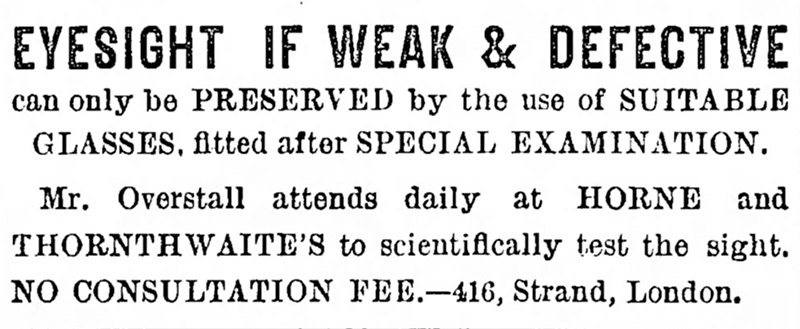
Figure 38.
An 1897 advertisement from the Guardian (London). One or both of the Overstalls had taken over Ackland’s service of examining eyes.
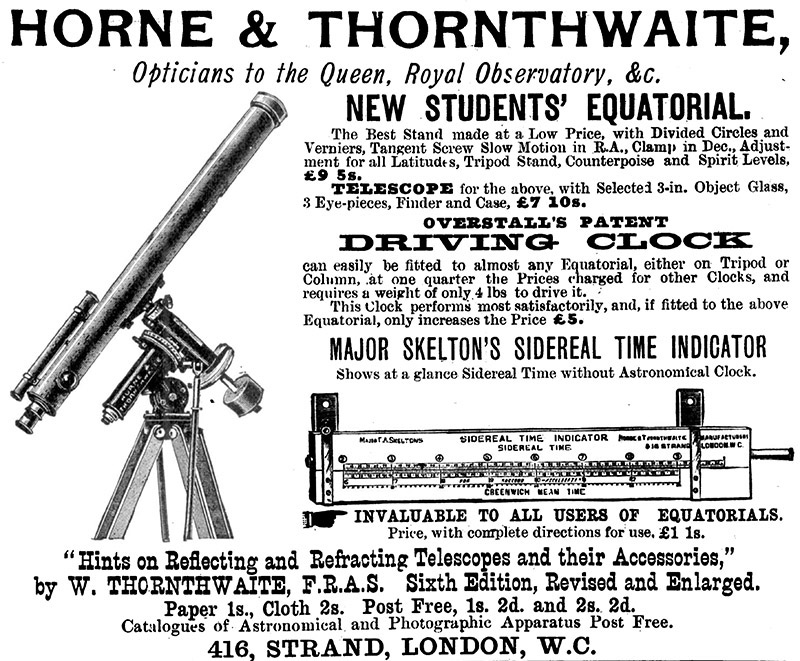
Figure 39.
A 1900 advertisement.
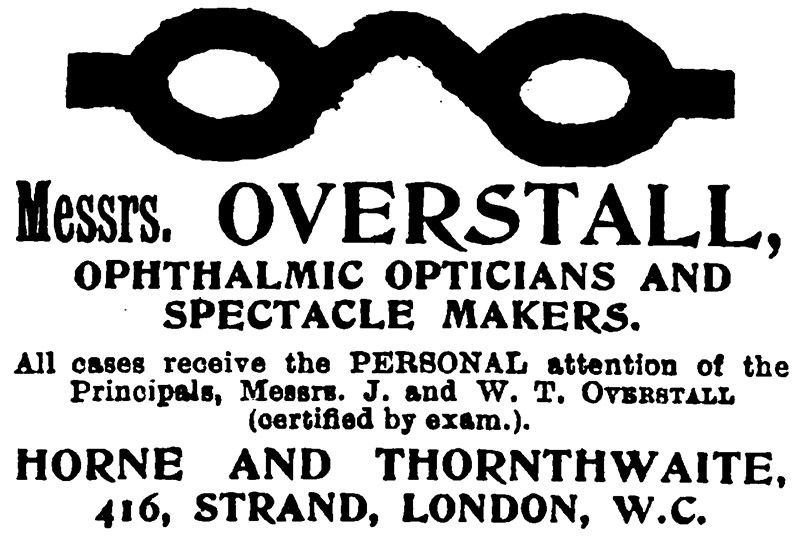
Figure 40.
1905 advertisement from “T.P.’s Weekly”.
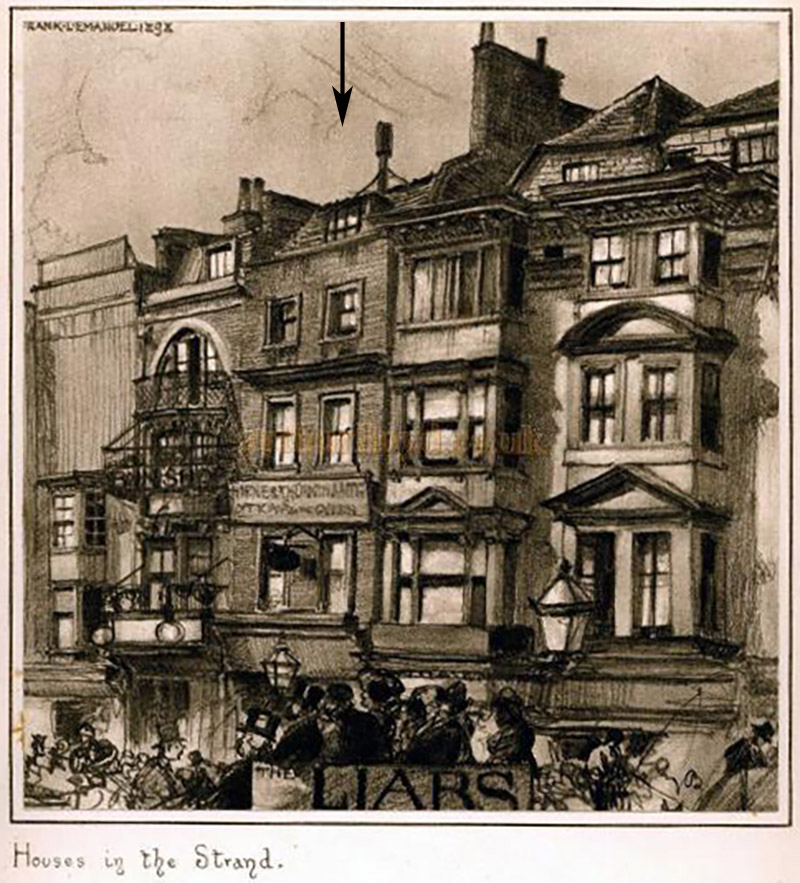
Figure 41.
The Strand, from Wilfred Witten’s “A Londoner’s London”, published in 1913. The Horne and Thornthwaite shop is indicated by an arrow.
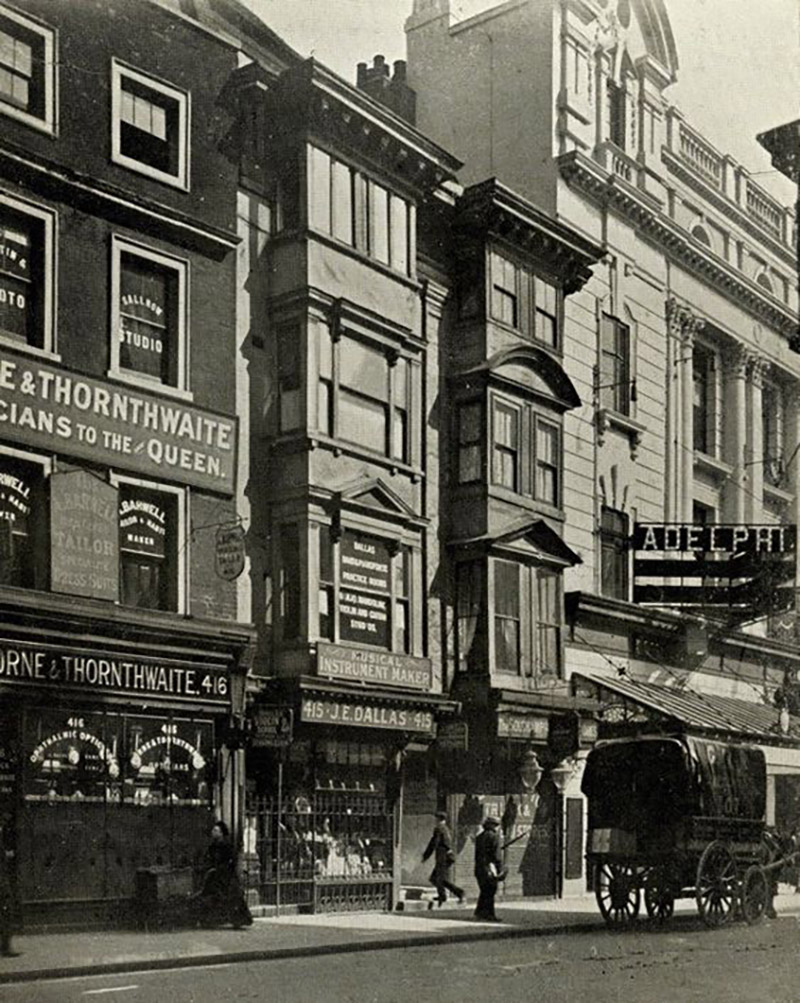
Figure 42.
Photograph of Horne and Thornthwaite, 416 Strand, ca. 1900s. The business was adjacent to the popular Adelphi Theatre. Upstairs windows announce the photographic studio of James Martin & Mary Ann Emma Sallnow, who operated from this location between 1884 and 1913.
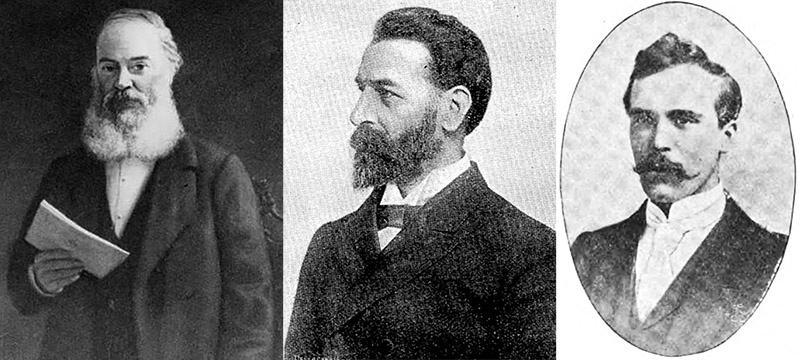
Figure 43.
Known photographs of owners/managers of the Horne, Thornthwaite, and Wood series of businesses. Left, William Henry Thornthwaite, from an 1894 obituary. Center, Augustus Alfred Wood, from “The Optical Magic Lantern Journal”, 1897. Right, William Thomas Overstall, from “The Photographic Dealer”, 1899.
Acknowledgments
Thank you to Allan Wissner for generously providing images from his collection, http://www.antique-microscopes.com.
Resources
Ackland, William (1847) Galvanism as a Remedial Agent, Ackland, London
Ackland, William (1857) How to Take Stereoscopic Pictures, Horne and Thornthwaite, London
Ackland, William (1857) Hints on the collodio-albumen process, Journal of the Photographic Society of London, Vol. 4, pages 56-58
Ackland, William (1867) Hints On Spectacles: When Required And How To Select Them, Horne and Thornthwaite, London
Ackland, William (1870) On a neutral tint "selenite stage.", Journal of the Quekett Microscopical Society, Vol. 2, page 145
Ackland, William (1885) Directions for Using Ackland's Improved Optometer and Optical Calculating Rule, Horne and Thornthwaite, London
The Athaeneum (1844) Advertisement for the auction of Edward Palmer’s stock, August 10, page 721
The Athaeneum (1844) Advertisement for the opening of Horne, Thornthwaite, and Wood, September 21, page 841
Boase, Frederic (1908) William Ackland, Modern English Biography, Vol. 4, Boase, Truro
British Journal of Photography (1895) William Ackland, Vol. 42, pages 221-222
Brock, William H. (2016) William Crookes (1832–1919) and the Commercialization of Science, Routledge
Catalogue of the Works exhibited in the British Section of the Exhibition, Exposition Universelle de 1855, Paris (1855) page 23
Chemical News and Journal of Physical Sciences (1861) Advertisement for Crookes’ spectrum apparatus, June 15
Chemical News and Journal of Physical Sciences (1864) Advertisement from E.G. Wood, February 13
Chemical Record (1851) Advertisement from Horne, Thornthwaite, and Wood, July 19, front cover
Departure/Arrival records of John Overstall on The Montrose (1911) accessed through ancestry.com
Departure/Arrival records of William Overstall and family on The Empress of Ireland (1911) accessed through ancestry.com
The Electrical Engineer (1895) New electrical firm (Wood and Co.), Vol. 15, page 270
England census and other vital statistics, accessed through ancestry.com
English Mechanic and Mirror of Science and Art (1867) Advertisements from Horne and Thornthwaite, Vol. 5, August 2, page v
English Mechanic and World of Science (1893) Advertisements, Vol. 58, October-November
Exhibition of the Works of Industry of All Nations, 1851: Reports of the Juries (1851) pages 257, 273, and 274
Guardian (London) (1897) Advertisement from Horne and Thornthwaite, April 14, page 579
Hassall, Arthur Hill (1855) Food and Its Adulterations, Longman, Brown, Green, and Longmans, London. Advertisement from Horne and Thornthwaite in rear of book
Hodson's Booksellers, Publishers and Stationers' Directory for London (1855) Advertisement from E.G. Wood
Horne, James Herbert (1846) A Guide to the Correct Administration of Medical Galvanism, and Companion to the Improved Electro-Galvanic Machines, Horne, Thornthwaite, and Wood, London
Horne and Thornthwaite (1857) Chloroform Superseded in Dental Operations, by a New Method of Inducing Insensibility to Pain, Horne and Thornthwaite, London
The International Exhibition of 1862, Official Catalogue of the Fine Art Department (1862) pages 46-49
James, F.A.J.L. (1981) The letters of William Crookes to Charles Hanson Greville Williams 1861-2: The detection and isolation of thallium, Ambix, Vol. 28, pages 131-157
Journal of the British Astronomical Association (1894) Election of John and William Overstall, Vol. 4, page 267
Journal of the British Astronomical Association (1900) Advertisement from Horne and Thornthwaite, Vol. 10
Journal of the Society of Arts (1857) Advertisements from Horne and Thornthwaite, and from E.G. Wood, Vol. 5, July 24
Knowledge (1897) Overstall’s patent driving clock, Vol. 20, page 71
The Lancet (1845) Advertisement from Horne, Thornthwaite, and Wood for medical galvanism, July 5 advertiser
The Lancet (1852) Advertisements from W. Ackland, Vol. 2, September 11 and December 4 advertisers
The Lancet (1874) Advertisements from Horne and Thornthwaite, January-February advertisers
The Lancet (1875) Advertisements from Horne and Thornthwaite, July-August advertisers
London Gazette (1854) Horne, Thornthwaite, and Wood became Horne and Thornthwaite, page 2370
London Gazette (1885) Dissolution of Horne and Thornthwaite
The London Medical Directory (1846) Advertisement from Horne, Thornthwaite, and Wood for medical galvanism, page 21
The London Medical Directory (1846) Horne, James Herbert, page 77
London Morning Post (1845) Improvement in galvanic apparatus (W. Ackland), April 21, page 8
Mechanic’s Magazine (1843) Review of Photographic Manipulation, Vol. 38, pages 518-521
Medals and Honourable Mentions Awarded by the International Juries (1862) pages 201-202, and 207
Medical Times (1850) Advertisements from Horne, Thornthwaite, and Wood
Notes and Queries (1855) Photographic Defense Fund, January 20 issue
The Observatory (1886) Advertisement from Horne, Thornthwaite and Wood, and from E.G. Wood, Vol. 9
Official Catalogue of the Great Exhibition of the Works of Industry of All Nations (1851) pages 61 and 63
Official Catalogue of the New York Exhibition of the Industry of All Nations (1853) page 101
Optical Magic Lantern Journal (1897) Portrait of Augustus A. Wood, April 1897
The Photographic Dealer (1898) William T. Overstall, Vol. 5, page 129
The Photographic Journal (1895) William Ackland, Vol. 19, page 207
The Photographic News (1886) Advertisement from Horne, Thornthwaite and Wood, and from E.G. Wood, Vol. 30
Photography (1898) Vol. 10, page 763
Probate of the Will of Fallon Horne (1858) “The Will of Fallon Horne late of Newgate-street in the City of London and of Ponces Minster in the Isle of Thanet in the County of Kent deceased who died 9 October 1858 at Ponces aforesaid was proved at the Principal Registry by the oaths of Edward Henry Horne of Manston St Lawrence in the said Isle Farmer the Brother and Dennis Rigden Charlton of Tunbridge in the said County Land Surveyor the nephew and two of the Executors. Effects under £2000”, accessed through ancestry.com
Probate of the Will of William H. Thornthwaite (1894) “Thornthwaite William Henry of Highbury hill house 14 Highbury-hill Middlesex died 20 February 1894 Probate London 21 March to William Henry Emilion Thornthwaite director of the Gresham life assurance society and James Falon Thornthwaite barrister-at-law Effects £11731 16s 10d”, accessed through ancestry.com
Probate of the Will of William Ackland (1895) “Ackland William of 19 St Luke’s-road Clapham Surrey died 30 March 1895 Probate London 8 May to Thomas Gans Ackland actuary Effects £1130 14s 7d”, accessed through ancestry.com
Probate of the Will of Edward G. Wood (1896) “Wood Edward George of 74 Cheapside London optician died 11 January 1896 Probate London 19 February to Augustus Alfred Wood optician Effects £1304 2s 4d”, accessed through ancestry.com
The Railway News (1869) Gresham Life Assurance Company, Vol. 12, page 459
Scherren, Henry (1897) Through a Pocket Lens, Religious Tract Society, London
Smee, Alfred (1846) The Potatoe Plant, Longman, Brown, Green, and Longmans, London
Smee, Alfred (1847) Vision in Health and Disease: the Value of Glasses for its Restoration, and the Mischief Caused by their Abuse, Horne, Thornthwaite, and Wood, London
The Student, and Intellectual Observer (1871) Ackland’s selenite stage, Vol. 5, page 552
Thornthwaite, William H. (1843) Photographic Manipulation, E. Palmer, London, editions 1 and 2
Thornthwaite, William H. (1845) A Guide to Photography, Horne, Thornthwaite, and Wood, London
Thornthwaite, William H. (1860) A Guide to Photography, Seventeenth Edition, Horne and Thornthwaite, London
T.P.’s Weekly (1905) Advertisement from Horne and Thornthwaite, April 21
Varley, Cornelius (1845) A Treatise on Optical Drawing Instruments, Horne, Thornthwaite, and Wood, London
Ward, Mrs. (1869) The Microscope, Third Edition, Groombridge and Sons, London
Ward, Mrs. (1869) The Telescope, Third Edition, Groombridge and Sons, London
Wood, Augustus A. (1885) Magic Lanterns: How Made and How Used, E.G. Wood, London
Wood, Augustus A. (1888) A Photograph and How to Take It, E.G. Wood, London
Family tree records from ancestry.com:
William Thornthwaite: https://www.ancestry.co.uk/family-tree/person/tree/65250437/person/44133081519/facts
John Overstall: https://www.ancestry.co.uk/family-tree/person/tree/104866702/person/360047098827/facts
William Overstall: https://www.ancestry.co.uk/family-tree/person/tree/104866702/person/360047098845/facts